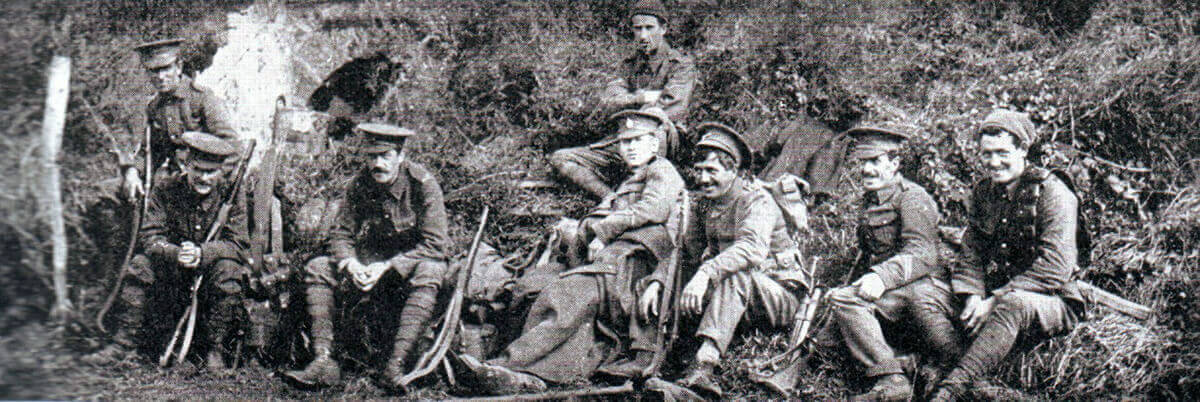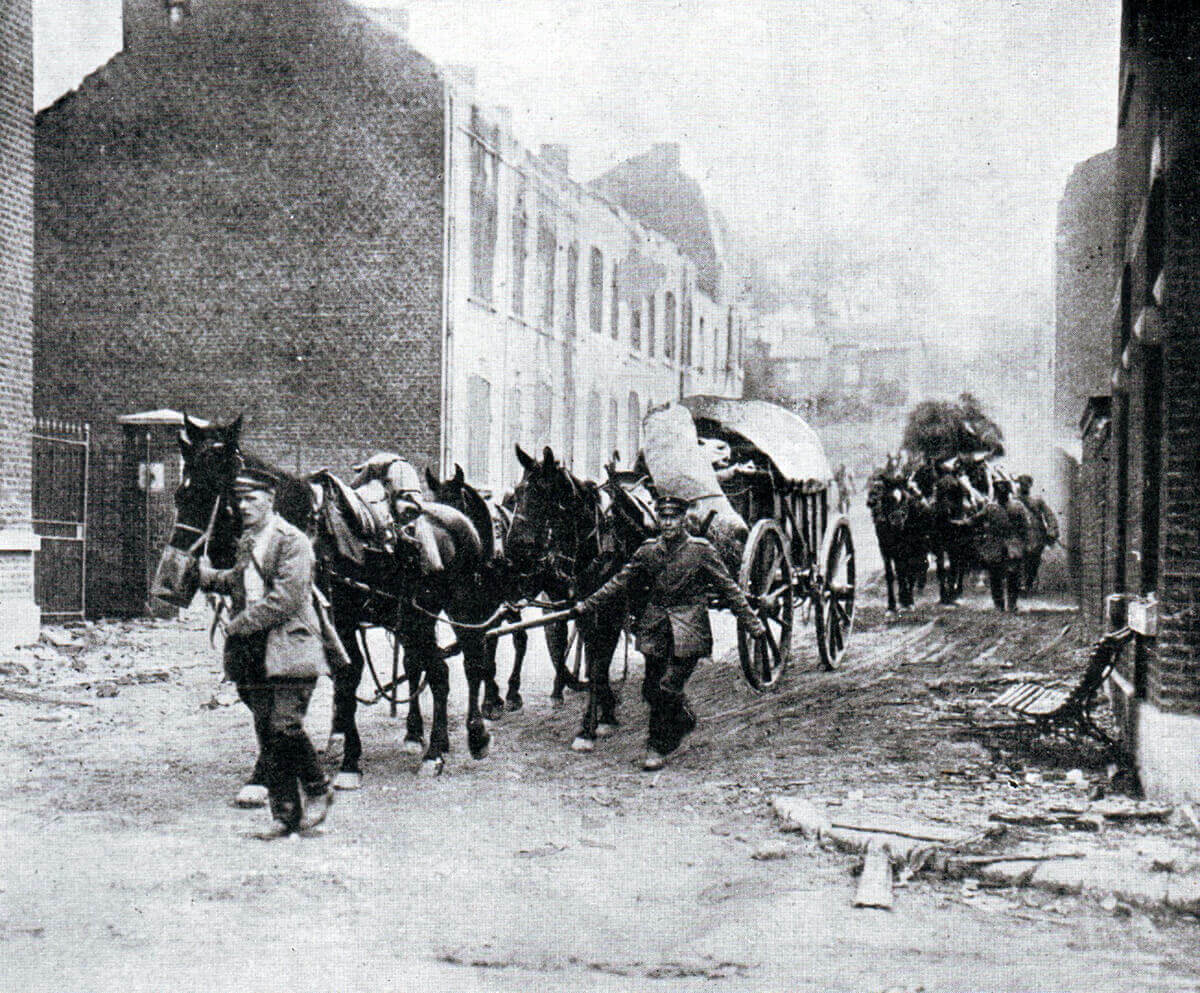The battle, fought from 10th to 13th September 1914 in the First World War, that saw the end of mobility and the beginning of four years of trench warfare on the Western Front
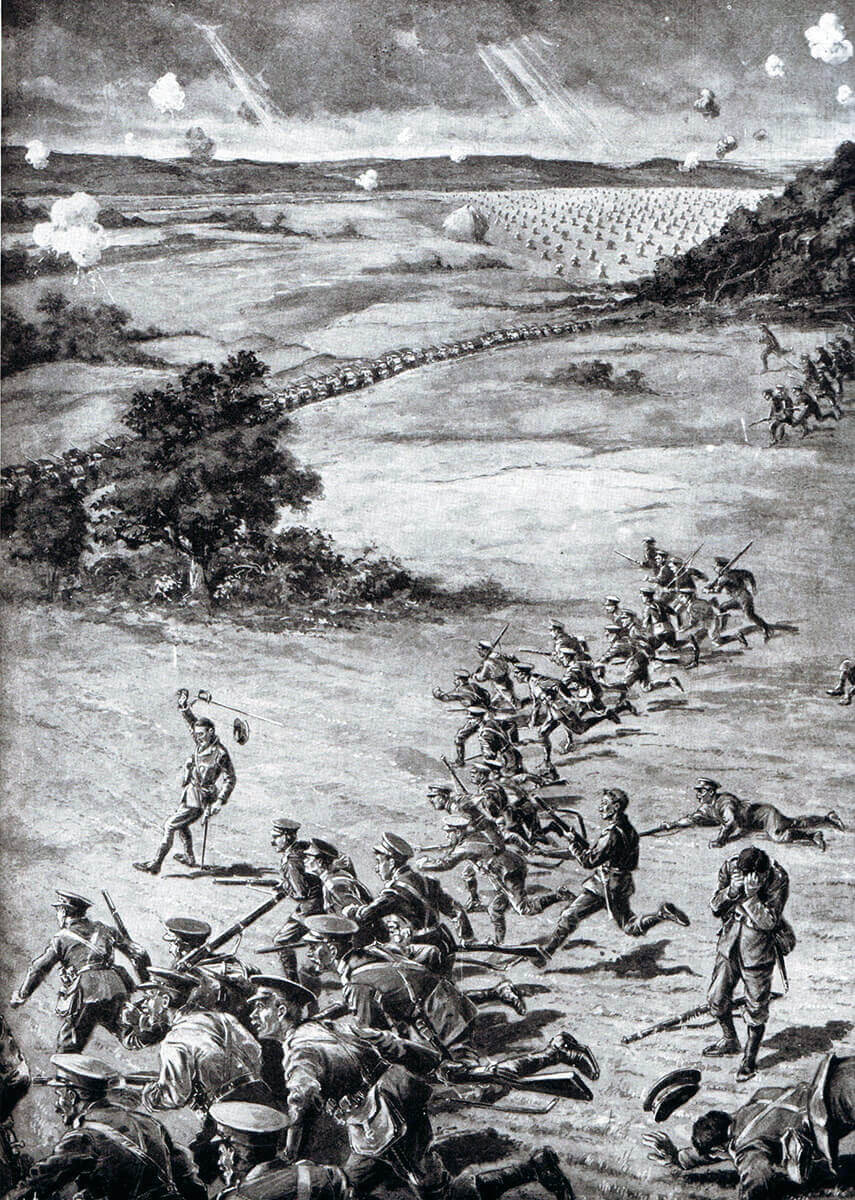
1st West Yorkshire Regiment in action at the Battle of the Aisne, 10th to 13th September 1914 in the First World War
The previous battle in the First World War is the Battle of the Marne
The next battle in the First World War is the Texel Action
Date of the Battle of the Aisne: 13th to 15th September 1914
Place of the Battle of the Aisne: On the Aisne River to the east of Soissons in Eastern France
War: The First World War.
Contestants at the Battle of the Aisne: The British Expeditionary Force (BEF) and the French Army against the German Western Army.
Commanders at the Battle of the Aisne: General Joffre commanded the French Army. Field Marshal Sir John French commanded the BEF. General Manoury commanded the French 6th Army. General Franchet D’Espèrey commanded the French 5th Army.
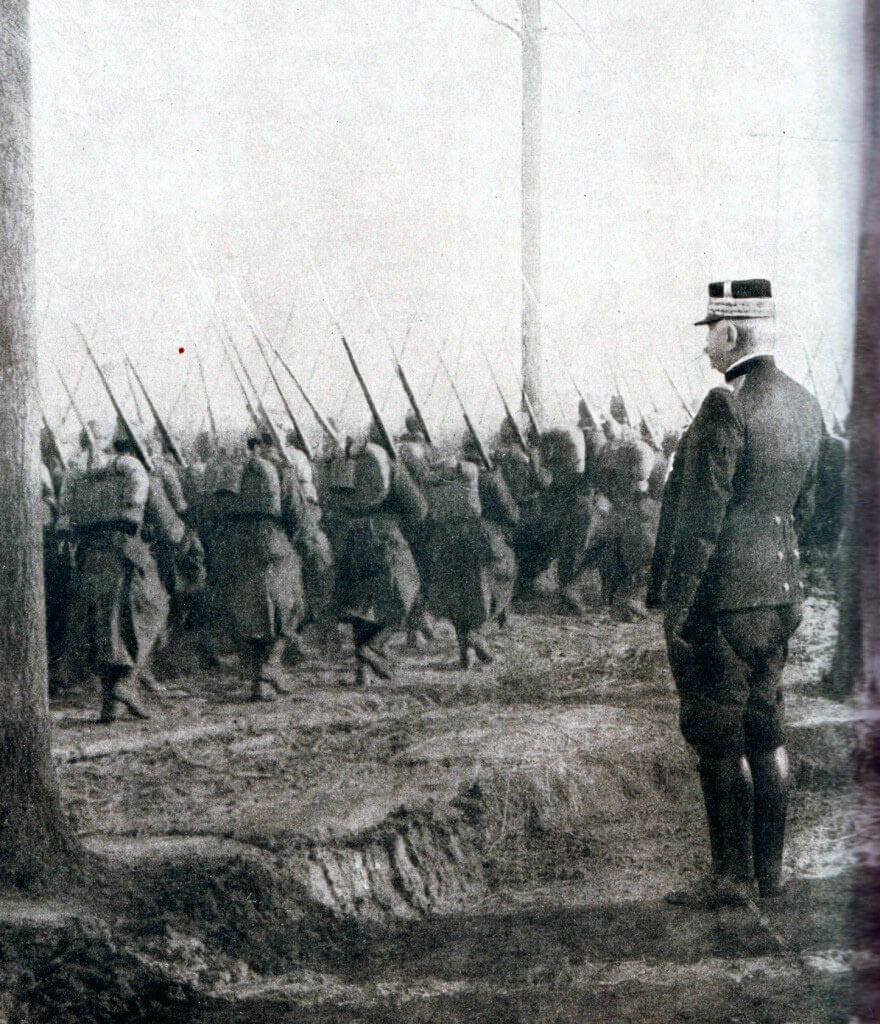
General Joffre, the French Commander-in-Chief, reviewing French troops: Battle of the Aisne, 10th to 13th September 1914 in the First World War
Generaloberst von Moltke was the German Chief of Staff and de facto commander of the German Armies in the West under the Kaiser, until he was replaced by Lieutenant General von Falkenhayn on 14th September 1914, during the Battle of the Aisne. Generaloberst von Kluck commanded the German First Army. Generaloberst von Bülow commanded the German Second Army. In view of von Kluck’s error in advancing to the south-east prior to the Battle of the Marne, thereby giving the BEF and the French 5th Army the opportunity to attack him in the flank, he was nominally subordinated to von Bülow for the German stand on the Aisne.
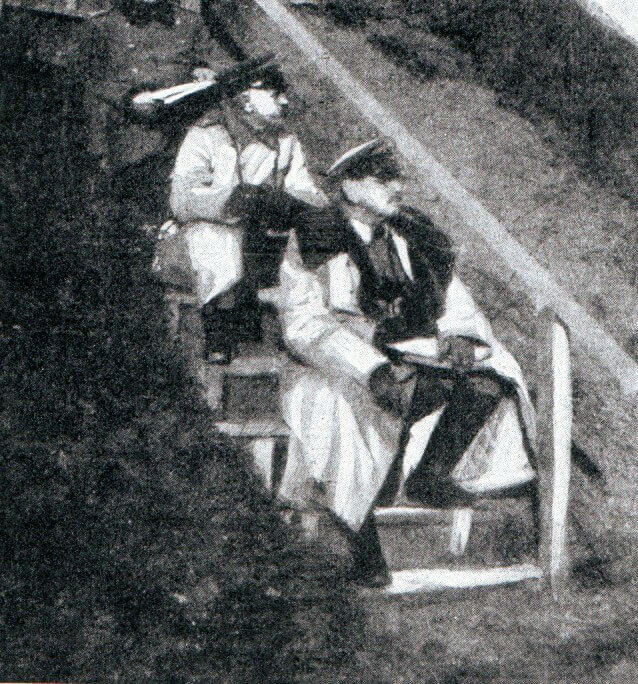
Generaloberst Alexander von Kluck commanding the German 1st Army: Battle of the Aisne, 10th to 13th September 1914 in the First World War
The BEF formations deployed in the Battle of the Aisne are as set out in BEF-Order of Battle.
German formations deployed in the Battle of the Aisne:
During the course of the battle the Germans moved fresh troops from the eastern end of their line to the west, to bolster the formations retiring behind the Aisne River in the Soissons area, whose morale was sapped by the long tiring advance followed by their precipitous retreat to the Aisne. Other units were released by the capture of the French fortress of Mauberge, near the Belgian border, on 8th September 1914. These new German formations arrived at various times during the Battle of the Aisne, on occasions just in time to rescue the German army from disaster.
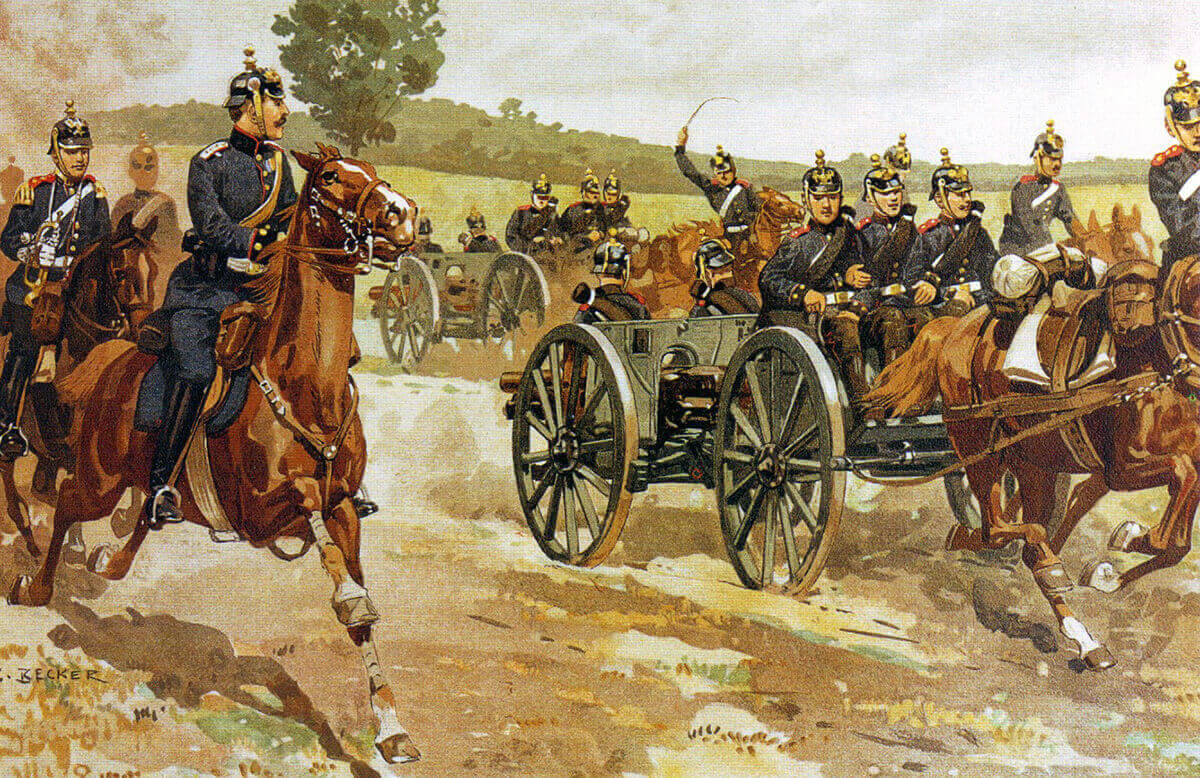
German artillery on manoeuvres in 1905 by Becker: Battle of the Aisne, 10th to 13th September 1914 in the First World War
At this time the German High Command was assembling a Seventh Army to take position on the western end of the German line and outflank the French. This step was delayed by the crisis on the Aisne and the consequent diversion of troops ear-marked for the Seventh Army.
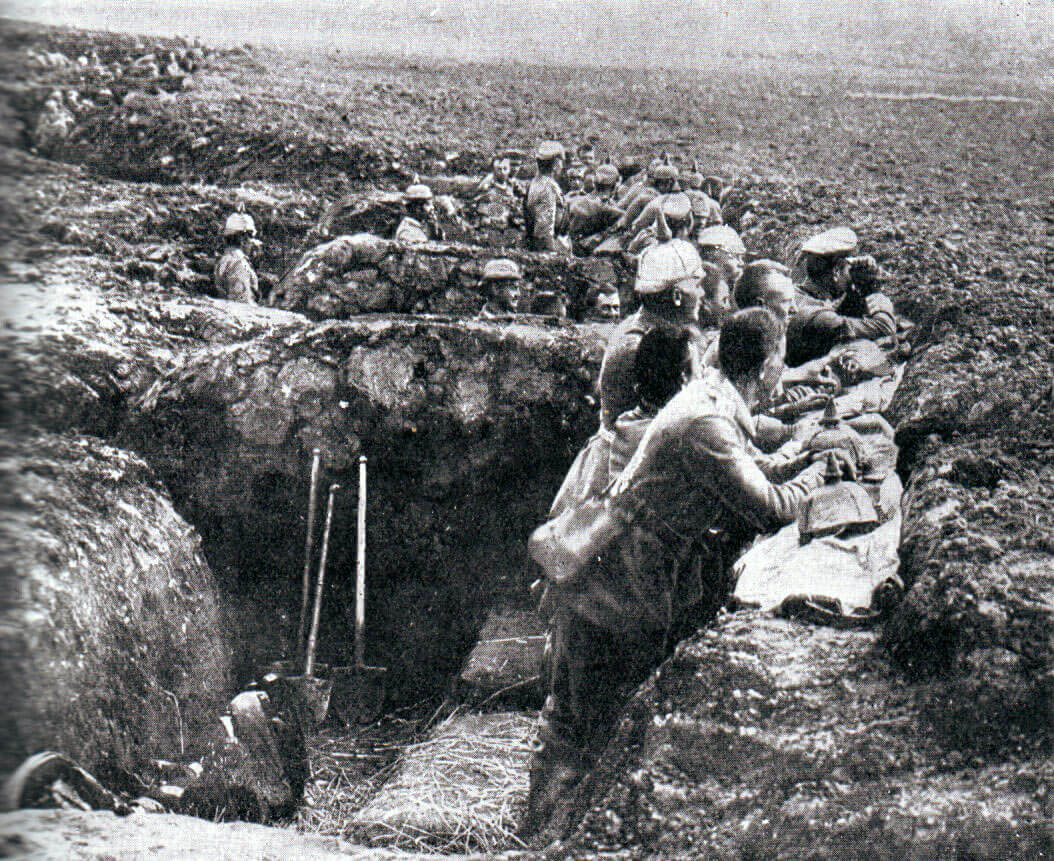
German entrenched position during the Battle of the Aisne, 10th to 13th September 1914 in the First World War
At the beginning of the Battle of the Aisne there was a gap of several miles between the German First and Second Armies, at the point where the BEF and the French 5th Army were advancing. The German VII Reserve Corps (13th and 14th Reserve Divisions) arrived from Mauberge on the Chemin des Dames on 13th September 1914, in time to meet the attack by the BEF’s I Corps and the neighbouring French XVIII Corps (5th Army).
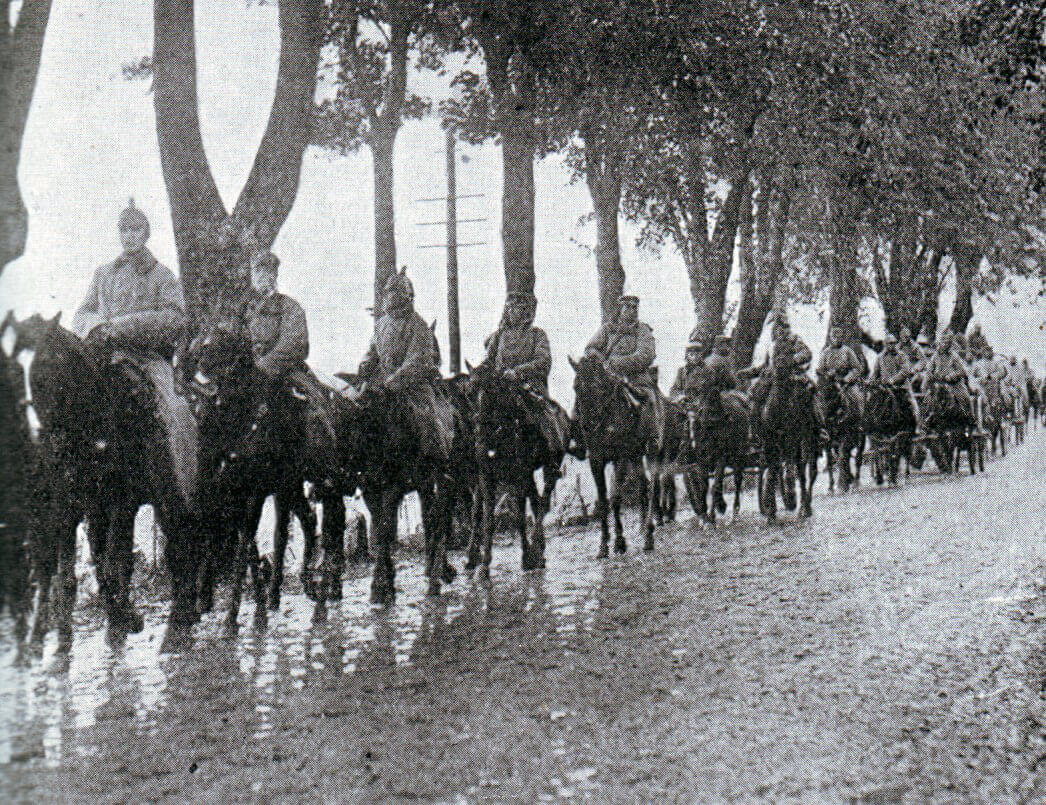
German cavalry advancing to the Aisne: Battle of the Aisne, 10th to 13th September 1914 in the First World War
By the end of the 13th September the German formations facing the BEF were; part of II Cavalry Corps (the Guard and 2nd Cavalry Divisions), VII Reserve Corps, III Corps and 34th Brigade (from IX Corps).
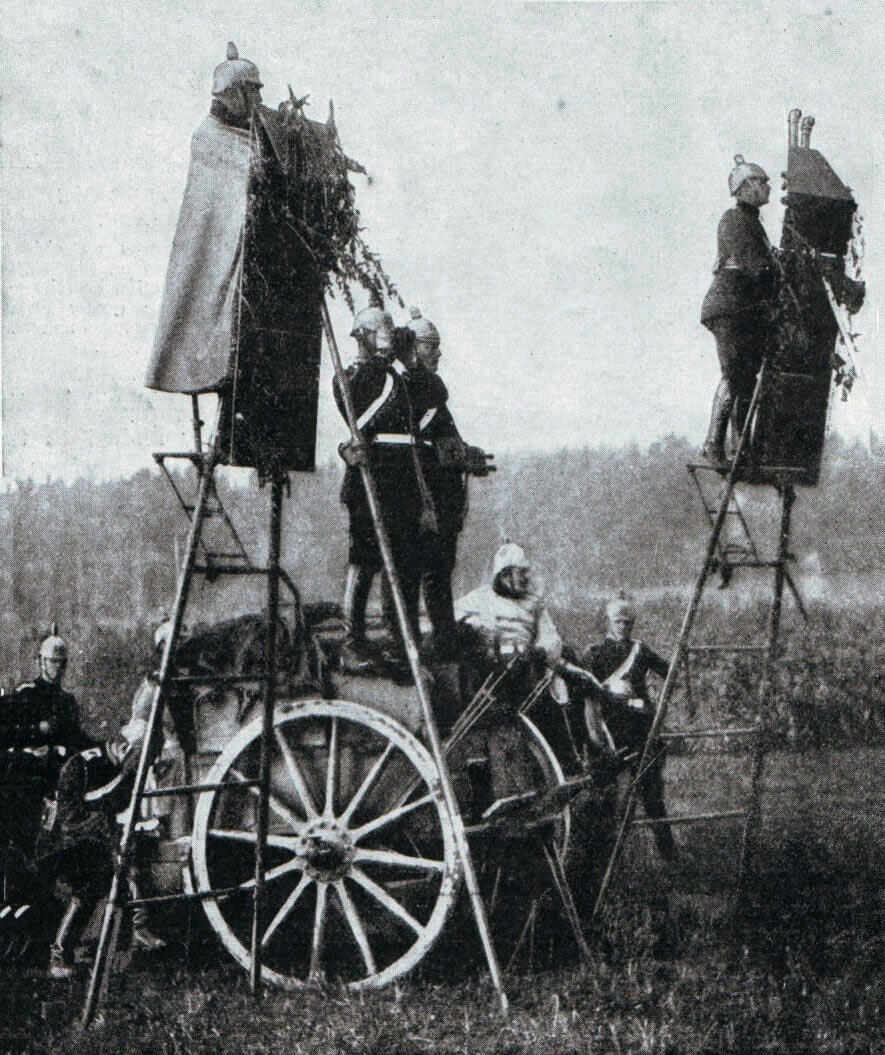
German field observation ladders: Battle of the Aisne, 10th to 13th September 1914 in the First World War
14th September 1914: von Bülow’s plan was to drive the BEF’s I Corps and the neighbouring French XVIII Corps back across the Aisne River. Von Bülow was awaiting the arrival of XV Corps from the German Seventh Army and the 7th Cavalry Division from the Sixth Army. The XV Corps started arriving in the area of Craonne on the Chemin des Dames plateau around 2pm on the 14th September, just in time to support the flagging VII Reserve Corps.
At the end of 14th September 1914 the German formations facing the BEF and the left of the French 5th Army were; II Corps, III Corps, VII Reserve Corps, 9th Cavalry Division, XV Corps, Guard Cavalry Division and 2nd Cavalry Division.
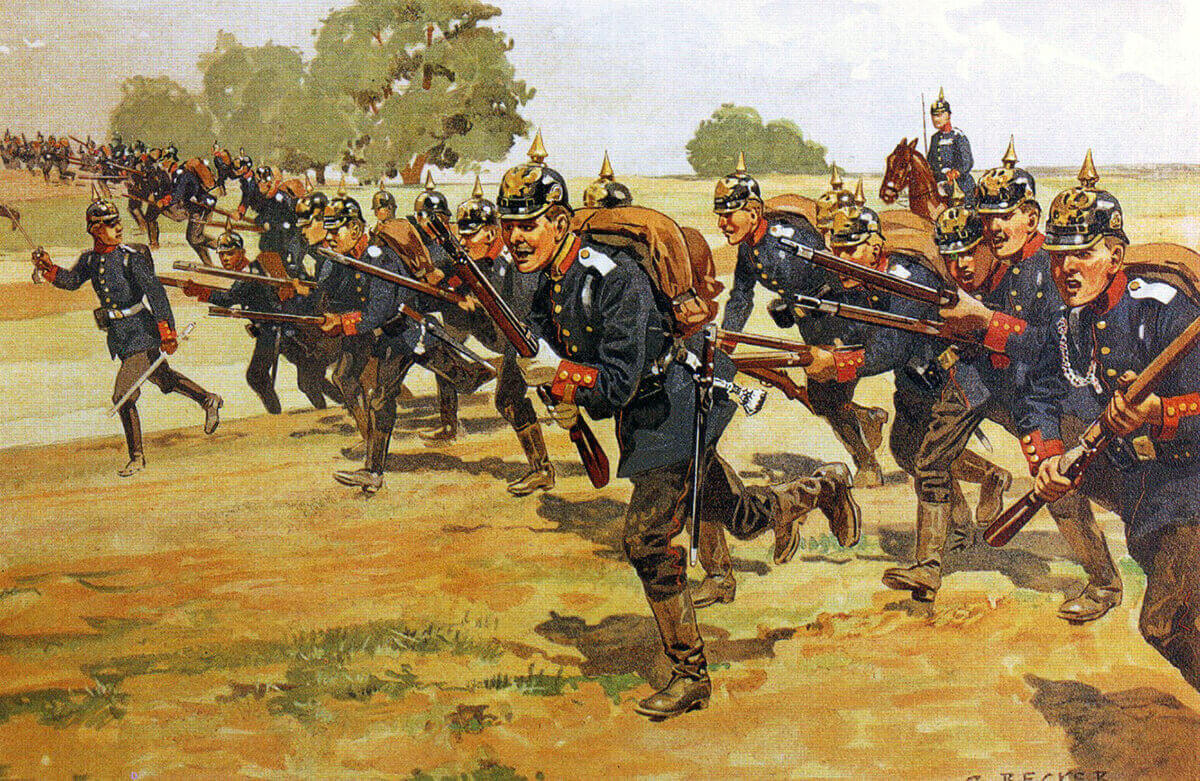
German infantry on manoeuvres in 1905: Battle of the Aisne, 10th to 13th September 1914 in the First World War: picture by Becker
During the night of 14th/15th September 1914 the Germans closed the gap between the First and Second Armies and their immediate crisis was over.
15th September 1914: This area of the German line was further reinforced by the arrival of IX Reserve Corps and 7th Cavalry Division.
Winner of the Battle of the Aisne: The Battle of the Aisne could best be described as a draw. The Germans failed to drive the BEF and the French back across the Aisne River, but the BEF and the French failed to take the Chemin des Dames plateau. The German retreat stopped on the plateau and both sides dug substantial trench networks, which remained the front line for several years.
Uniforms and equipment: See this section in the ‘Battle of Mons’.
Background: See this section in the ‘Battle of Mons’.
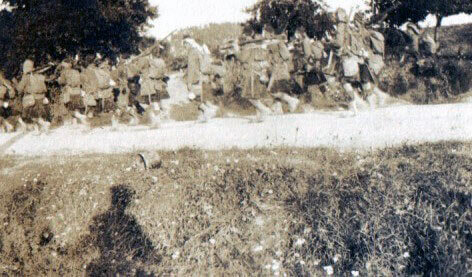
Cameron Highlanders advancing to the Aisne (photo by Captain Harry Baird, ADC to General Haig): Battle of the Aisne, 10th to 13th September 1914 in the First World War
Account of the Battle of the Aisne, 10th to 13th September 1914:
Following the battle to cross the Marne the British Commander-in-Chief, Field Marshal Sir John French, ordered the British Expeditionary Force (BEF) to continue its advance north towards the River Aisne.
General Joffre, the French Commander-in-Chief, ordered the French 5th Army with General Conneau’s cavalry corps, positioned to the east of the BEF, to continue the advance beyond the Marne, and the French 6th Army, positioned to the north-west of the BEF, to continue its advance to the north-east.
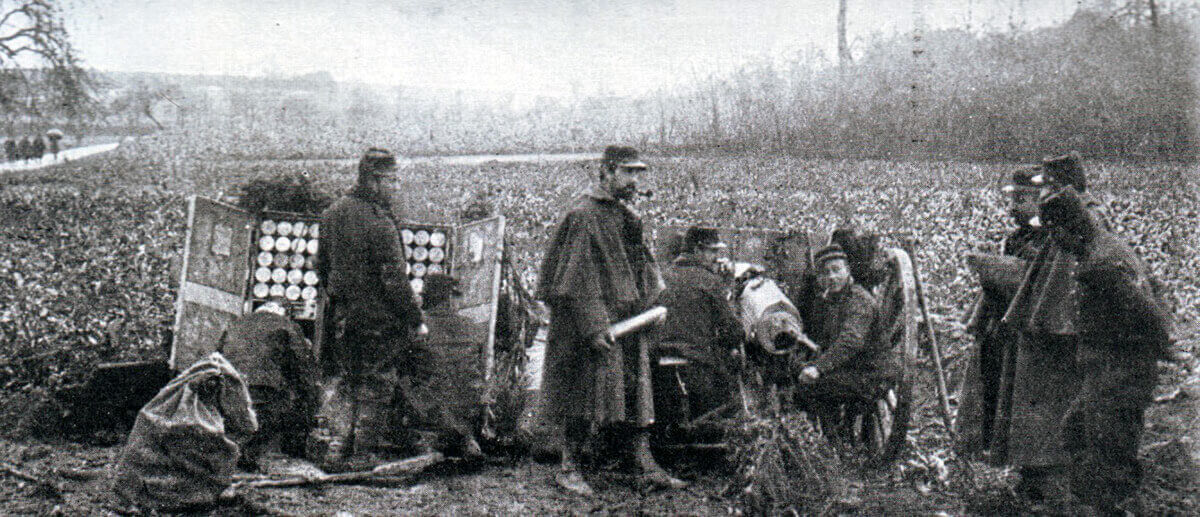
French 75mm field gun ready for action during the Battle of the Aisne, 10th to 13th September 1914 in the First World War
The BEF was at this stage in the campaign in France heavily dependent on reconnaissance by the aircraft of the Royal Flying Corps, to provide information on the whereabouts and movements of the opposing German formations. Low cloud and mist severely hindered aerial reconnaissance during 10th to 12th September 1914.
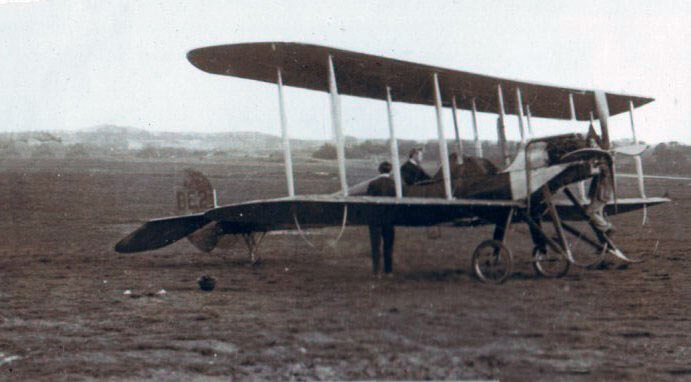
British BE2 Biplane (photo taken for Captain Harry Baird, ADC to General Haig) Captain Baird is in the passenger seat: Battle of the Aisne, 10th to 13th September 1914 in the First World War
At the end of 12th September 1914 the BEF was across the Vesle River, close up to the Aisne River, with the Cavalry Division at Dhuisel, Villers and Vaustin, I Corps at Dhuisel, Vaucère, Bazoches Paars and Courcelles, 2nd Cavalry Division at Chassemy, II Corps at Brenelle, Braisne, Serches and Chacrise, and III Corps at Septmonts and Buzancy.
The indications were that, after its long retreat to the Marne River and then to the Aisne River, The German army intended to defend the line of the Aisne. However there was uncertainty on the British and French side as to whether the Germans intended to stand and fortify the line of the Aisne, or whether this was a strong rearguard action before a further retreat.
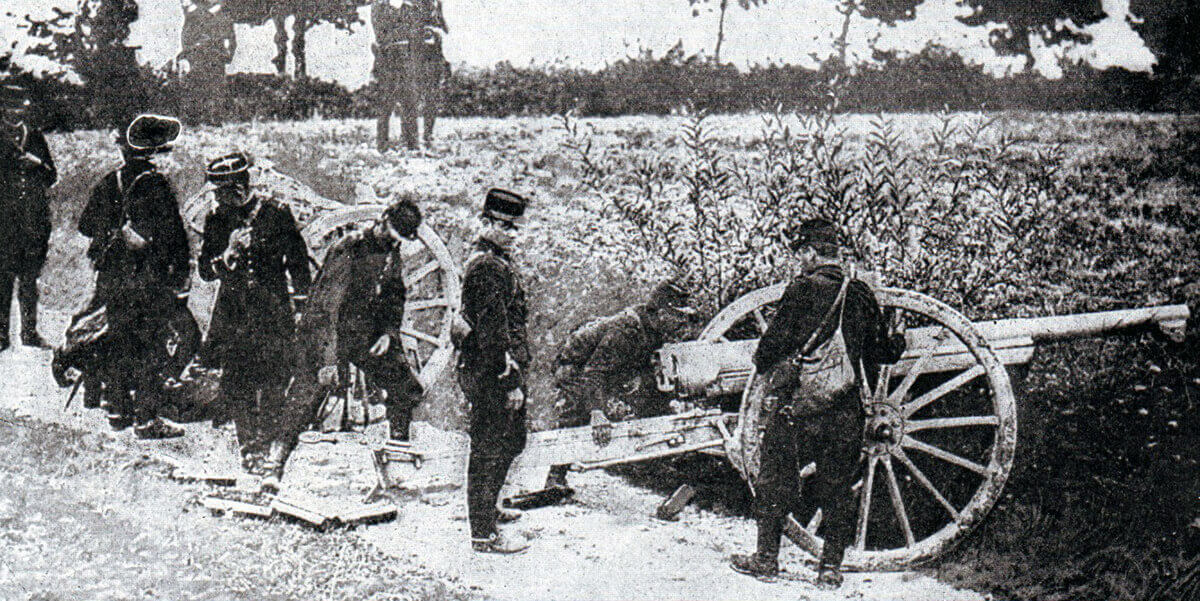
French 75mm field gun ready for action during the Battle of the Aisne, 10th to 13th September 1914 in the First World War
The Aisne River on this stretch is around 100 metres wide, slow and unfordable. Its valley varies from 1 to 2 miles in width, edged by sharp steep wooded inclines with spurs and re-entrants; good country for defence, difficult to attack.
Where the BEF was approaching the Aisne, the river was crossed by 8 bridges and, between Bourg and Venizel, an aqueduct carrying the Oise-Aisne canal.
Aerial reconnaissance showed that substantial German forces were moving east from Soissons, with the apparent intention of bolstering the troops opposing the BEF crossing of the Aisne.
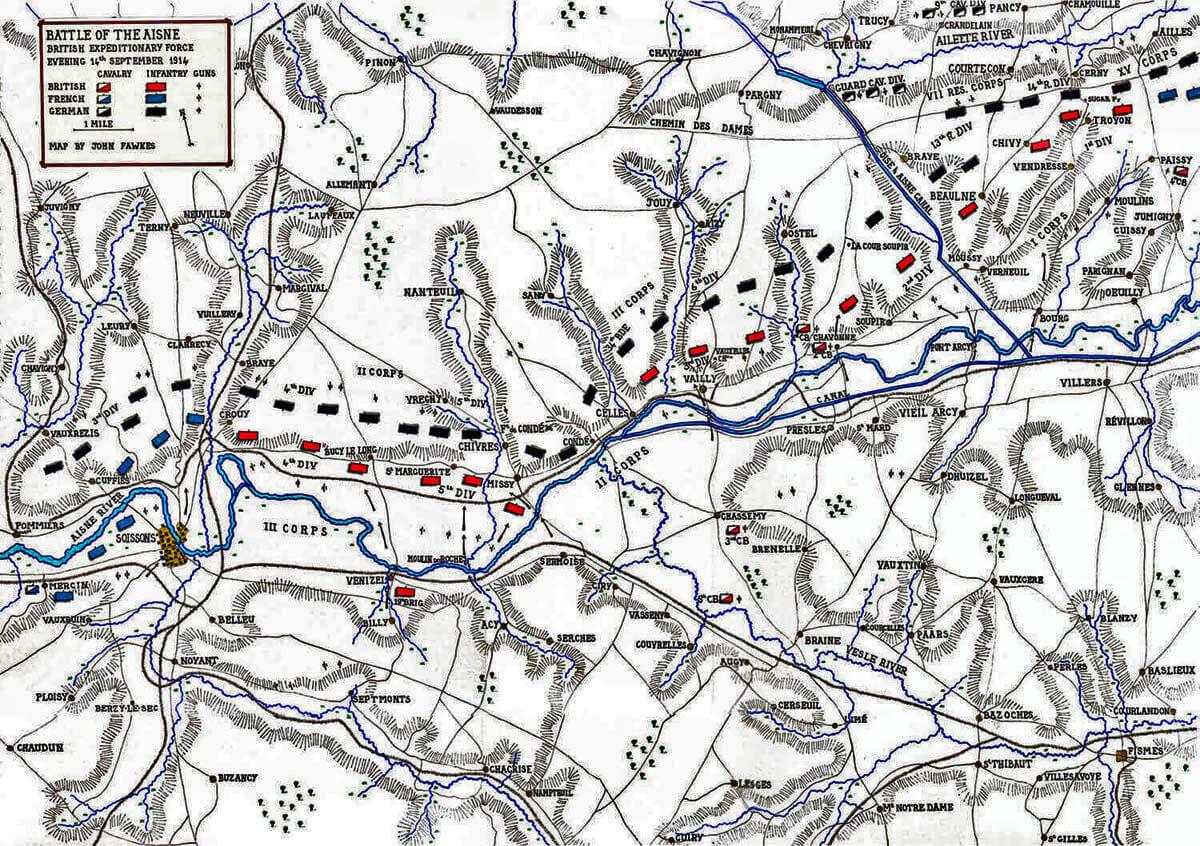
Map of the Battle of the Aisne, 10th to 13th September 1914 in the First World War: map by John Fawkes
By the end of 12th September 1914 the retreat by the German 1st and 2nd Armies was complete, and these formations were preparing to defend the line of the Aisne against any further advance by the BEF or the French Fifth Army. During the evening the German units from the 1st Army that were still south of the Aisne withdrew across the river.
General Joffre’s orders for the following day required the BEF to advance and cross the Aisne River between Soissons and Bourg, a stretch of river around 15 miles in length, the French Fifth Army to cross the Aisne on the BEF’s right flank and the French Sixth Army to outflank the Germans to the north-west. Sir John French directed the BEF’s advance to begin at 7am with targets for the day some 5 miles north of the Aisne River, along the high ground of the Chemin des Dames road (to become notorious in the war).
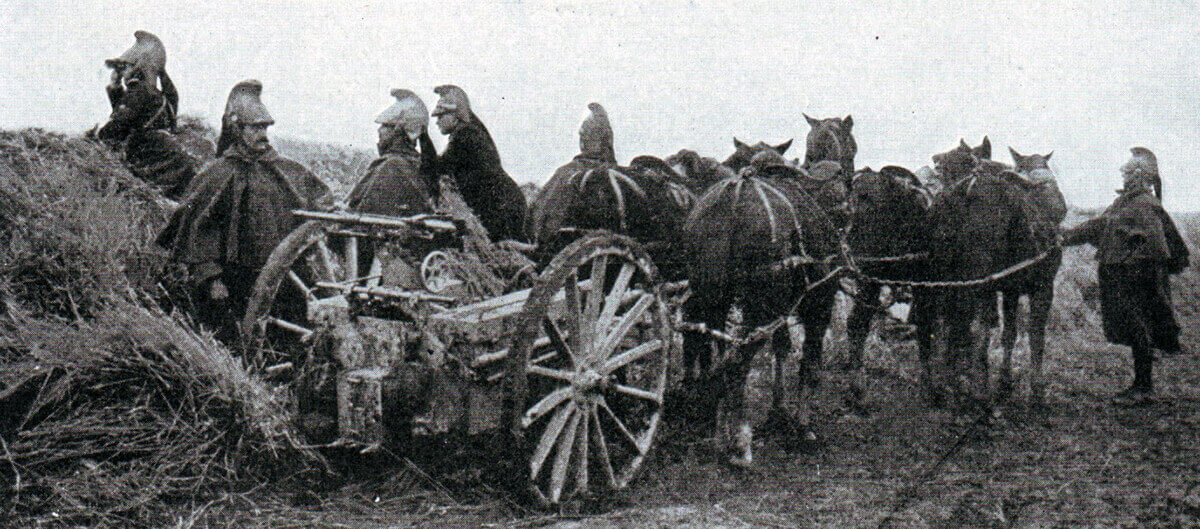
French dragoons with a machine gun during the Battle of the Aisne, 10th to 13th September 1914 in the First World War
The BEF’s I Corps was to cross the Aisne at Bourg, Pont Arcy and Chavonne; II Corps and the 3rd and 5th Cavalry Brigades at Vailly, Condé and Missy; III Corps at Venizel and Soissons.
The ensuing battle for the Aisne crossings and then the high ground to the north of the river took place during the morning in near continuous rain.
During the night of 12th September Brigadier-General Hunter-Weston took his 11th Brigade (4th Division of II Corps), after an approach march of around 30 miles largely in pouring rain, across the damaged bridge at Venizel, the men crossing in single file. His brigade at dawn captured the heights on the north side of the river in a bayonet charge, the surprised Germans not staying to contest the position. The brigade then extended its hold on the ridge westwards by around 3 miles, to a position short of the village of Crouy. This was considered to be the most successful part of the battle for the BEF and was attributed to General Hunter-Weston’s enterprise.
Between Missy and Vailly a canal branched off from the Aisne and followed the course of the main river, between 100 metres and half a mile to its south. The British units operating to the east of Missy therefore faced two waterways to cross, before they could get at the German positions to the north of the Aisne.
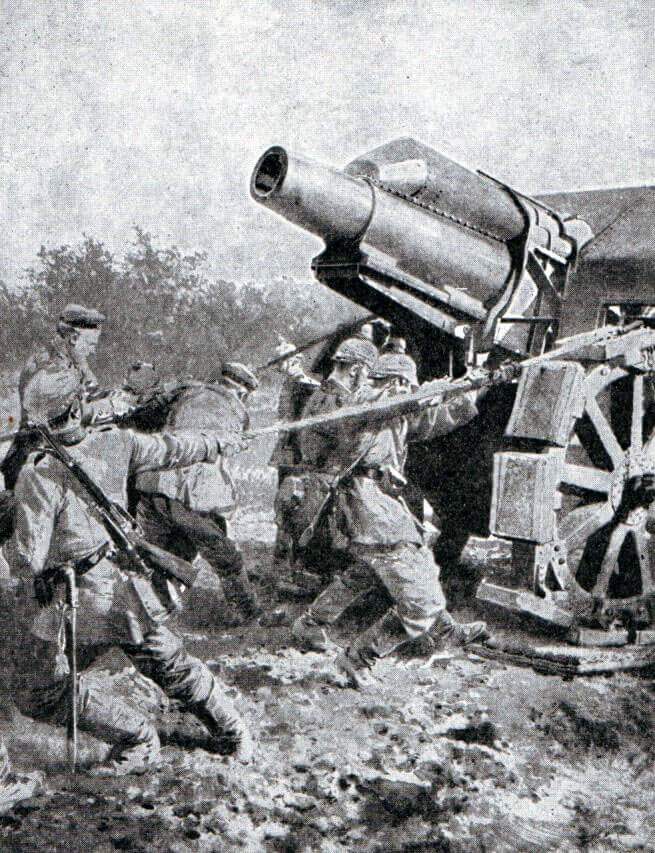
German heavy howitzer dragged into position during the Battle of the Aisne, 10th to 13th September 1914 in the First World War
General Allenby’s Cavalry Division began an attack on the BEF’s right against the German positions along the Aisne in the area of Villers and Bourg, but found that all the bridges across the Aisne, as opposed to the canal, were destroyed. German infantry in positions along the canal held the cavalry in check, until infantry support from the 1st Division of the BEF’s I Corps came up.
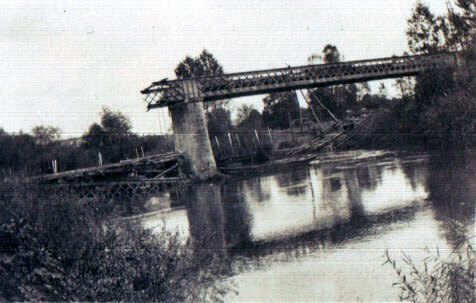
The demolished bridge at Bourg (photo by Captain Harry Baird, ADC to General Haig): Battle of the Aisne, 10th to 13th September 1914 in the First World War
The 2nd Brigade of the 1st Division assisted the cavalry in crossing the Aisne at Bourg and then occupied positions on the north bank of the river, while the cavalry brigades fanned out on various missions; 1st Cavalry Brigade heading east to make contact with the French and 2nd Cavalry Brigade advancing north towards the Chemin des Dames ridge in pursuit of a retreating German column. German artillery fire forced the 2nd Cavalry Brigade to abandon its pursuit and fall back from the ridge.
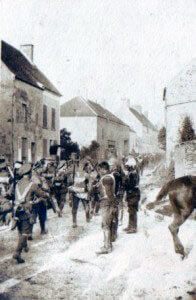
4th (Guards) Brigade passing French cuirassiers (photo by Captain Harry Baird, ADC to General Haig): Battle of the Aisne, 10th to 13th September 1914 in the First World War
The 2nd Division of I Corps advanced on Chavonne and Pont Arcy. Divisional cavalry reported that the bridge at Chavonne was destroyed and covered by sniper fire. 5th Brigade found the bridge at Pont Arcy damaged but usable and crossed in the face of limited opposition. In both towns Royal Engineers came up and began the work of restoring the bridges.
Further west 3rd Division of II Corps advanced on Vailly, where the Aisne River and Canal run closely in parallel, and 5th Division of II Corps tackled the crossing at Missy, 5 miles further west. The bridge at Condé half way between them was intact but difficult to approach, the valley being wide and empty of cover.
8th Brigade, heading the 3rd Division advance, encountered considerable German resistance in advancing on Vailly, the divisional artillery being subjected to heavy counter-battery fire, which in the case of 49th Battery forced the gunners to abandon their guns for a time
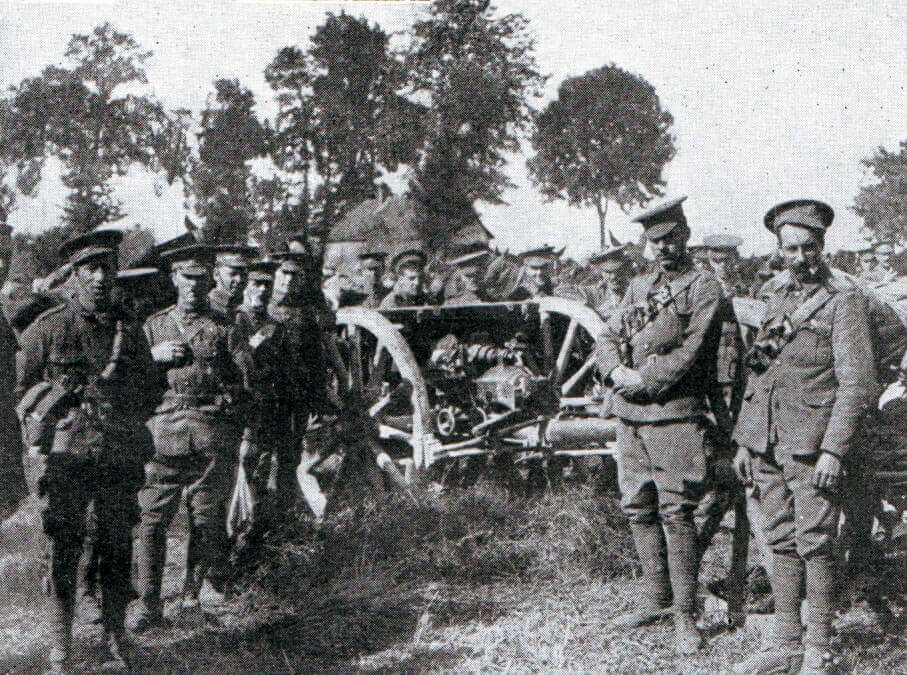
British RFA 18 pounder field gun and crew during the Battle of the Aisne, 10th to 13th September 1914 in the First World War
The 5th Division found the bridge at Missy to be broken and was unable to cross the river. At the same time the division’s 14th Brigade with 121st Battery RFA escorted 17th Company Royal Engineers to a site called ‘Moulin des Roches’ between Missy and Venizel, where the Royal Engineers spent some hours constructing a raft to cross the Aisne.
At Venizel, 12th Brigade headed the balance of III Corps across the now much improved bridge, captured the night before by Hunter-Weston’s 11th Brigade. To the left of the BEF, in Soissons, a brigade of the French 6th Army crossed the river.
The allied crossings in Venizel and Soissons were subjected to fire from German artillery of the heaviest calibres so far encountered in the War; howitzers of 8 inch and 5.9 inch, firing from 3 batteries positioned on the Chivres ridge to the north-east of Missy. This fire was met by the artillery of the 4th and 5th Divisions, now in position along the ridge to the south of the Aisne north of Venizel. The size of the German guns meant that they dominated the artillery exchange and the area.
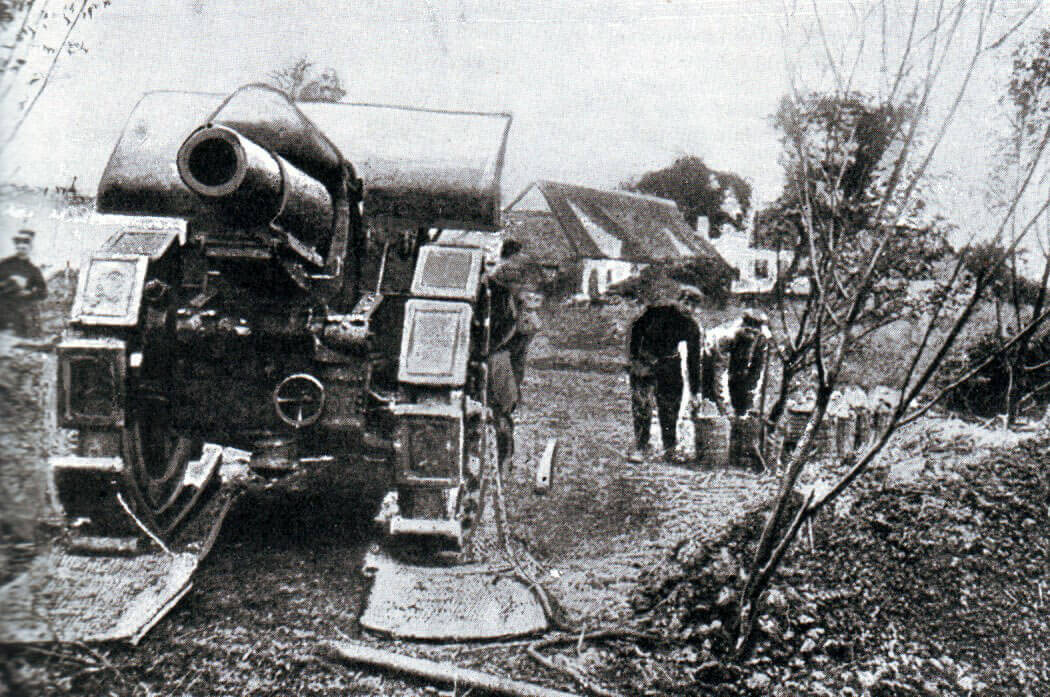
German heavy howitzer during the Battle of the Aisne, 10th to 13th September 1914 in the First World War
In spite of the German artillery fire the 12th Brigade crossed the Aisne, less 2nd Inniskilling Fusiliers, and advanced to the foot of the heights, followed by the 68th Battery RFA. The division’s 10th Brigade deployed along the railway embankment to the west of Venizel, to provide cover in case the division was forced back across the Aisne.
Hunter-Weston’s 11th Brigade was active on the heights to the north of the Aisne, its 1st Rifle Brigade advancing up the Chivres valley and firing on German positions in enfilade.
By noon on 13th September 1914 the BEF was across the Aisne on its left and its right.
In the early afternoon the 3rd Division renewed its attempt to cross the Aisne at Vailly. The railway bridge was unusable, but a single plank remained in place across the road bridge. At 3pm 2nd Royal Scots and 2nd Royal Irish Regiment of 8th Brigade began to cross the plank in single file under artillery fire and by 4pm were in position 1 ½ miles to the north-east of Vailly, at the chateau at the head of the Vailly re-entrant.
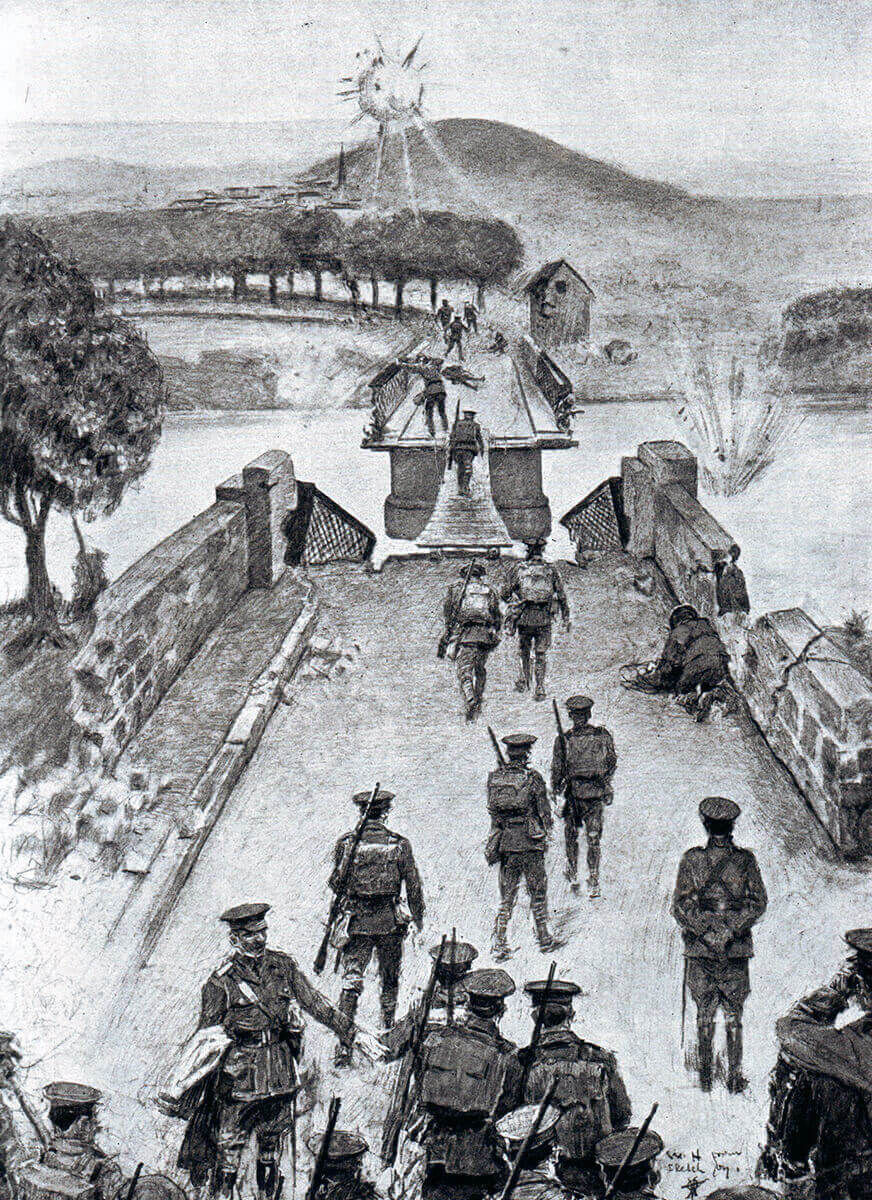
British 8th Brigade crossing the broken bridge over the Aisne at Vailly on 13th September 1914 by the single plank: Battle of the Aisne, 10th to 13th September 1914 in the First World War
The division’s 9th Brigade crossed the single plank during the night, while the Royal Engineers built a pontoon bridge, the Germans continuing their artillery bombardment of the bridge area.
During the night at Missy, the 1st Royal West Kents of 13th Brigade crossed the river in small groups, using a boat taken from the north bank by a sapper who swam across, and on five rafts constructed by the Royal Engineers. 2nd King’s Own Scottish Borderers followed, with both battalions across by the morning. A German patrol that came to investigate was annihilated. The other two battalions of the brigade remained south of the Aisne.
At Moulin des Roches, above Venizel, the Royal Engineers completed a raft able to carry 60 men, enabling the 2nd Manchesters of 14th Brigade to cross the Aisne during the afternoon of the 13th September, followed by 1st East Surreys. Both battalions moved forward under a heavy German artillery bombardment to support an attack being launched by 12th Brigade from Missy onto the Chivres Spur.
In this attack 2nd Lancashire Fusiliers and 2nd Essex advanced up the road from Missy to Chivres, coming under heavy fire from the entrenched German infantry. The Fusiliers were stopped short of Chivres and were unable to push on further. They, the 1st Rifle Brigade to their left rear and the Gunners all suffered heavy casualties, the advance halting there.
At dusk the Lancashire Fusiliers were relieved by the 2nd Manchesters and withdrew. The 12th Brigade got no further forward that night.
At around 9pm the 14th Brigade marched to the 60 man raft at Moulin des Roches and spent the night crossing to the north bank of the Aisne.
During the night of the 13th/14th September 1914 the BEF’s advanced formations were at these locations:
Cavalry Division, 1st Division and 5th Brigade of I Corps between Paissy and Verneuil, around 2 to 3 miles north of the Pont Arcy and Bourg crossings.
There was then a 5 mile gap to the 8th and 9th Brigades at Vauxelles,
There was then a 3 mile gap to the right of 1st RWK and 2nd KOSB of 13th Brigade at Missy, on the north side of the Aisne.
14th and 15th Brigades and 4th Division between Sainte Marguerite and Crouy.
The following formations remained on the south bank of the Aisne:
4th (Guards) and 6th Brigades in the group of villages to the south of Pont Arcy; Vieil Arcy, Dhuizel and St. Maard.
3rd and 5th Cavalry Brigades with 7th Brigade around Braisne.
The remaining two battalions of 13th Brigade to the south of Missy.
19th Brigade (II Corps reserve) at Septmonts.
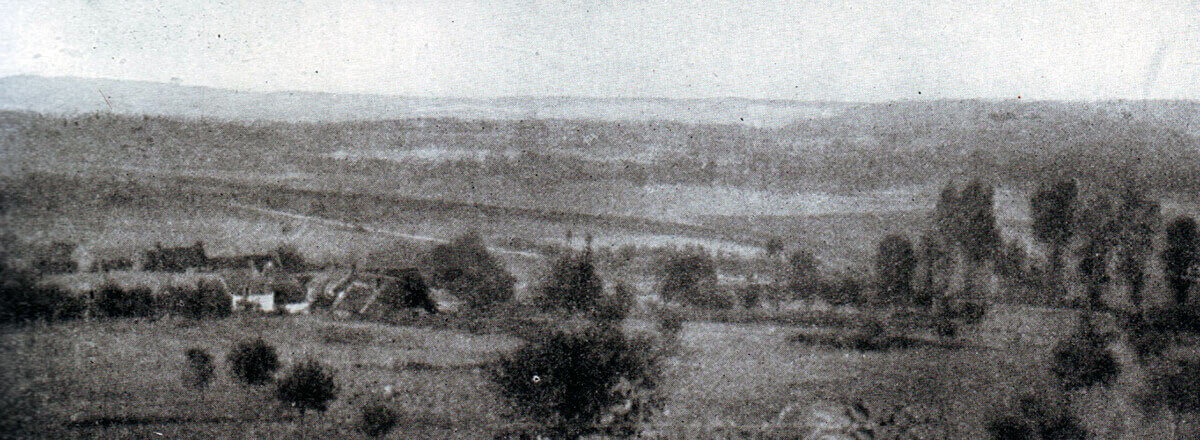
The Aisne battlefield near Braisne: Battle of the Aisne, 10th to 13th September 1914 in the First World War
The French 5th Army on the right of the BEF and the French 6th Army on its left during the day faced similar difficulties to the British, heavy German artillery placed well back and able to bombard the attacking infantry and guns, with limited prospect of counter-battery fire, particularly during the heavy rain and mist.
The Chemin des Dames ridge remained the immediate goal for the Allied attack along the Aisne.
14th September 1914:
Field Marshal Sir John French determined to continue the attack begun the previous day. It was still far from clear whether the German army intended to continue its retreat or to stand firm on the Aisne defensive line. Air observation during the afternoon of the 13th September suggested the presence of only two German infantry divisions and two German cavalry divisions in the area in front of the BEF.
This turned out to be a substantial underestimate of German strength along the ridges to the north of the Aisne River.
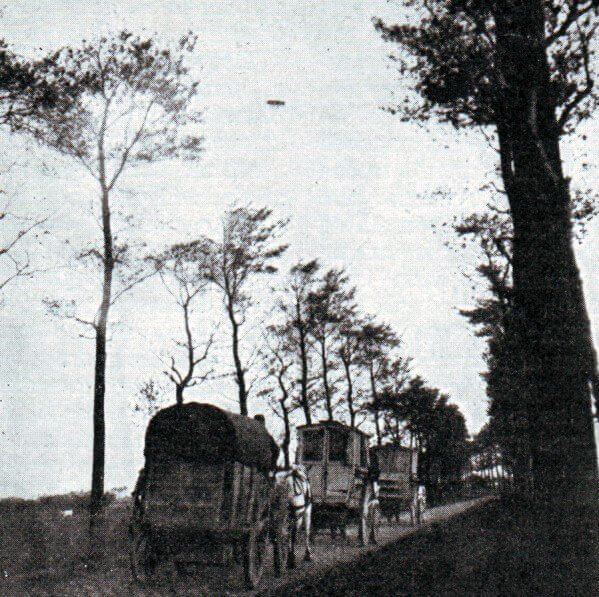
British biplane flying over the battlefield: Battle of the Aisne, 10th to 13th September 1914 in the First World War
During the night the Royal Engineers worked to establish two new crossings at Vailly and begin work on the badly damaged bridge at Missy. Other means of crossing the Aisne were identified.
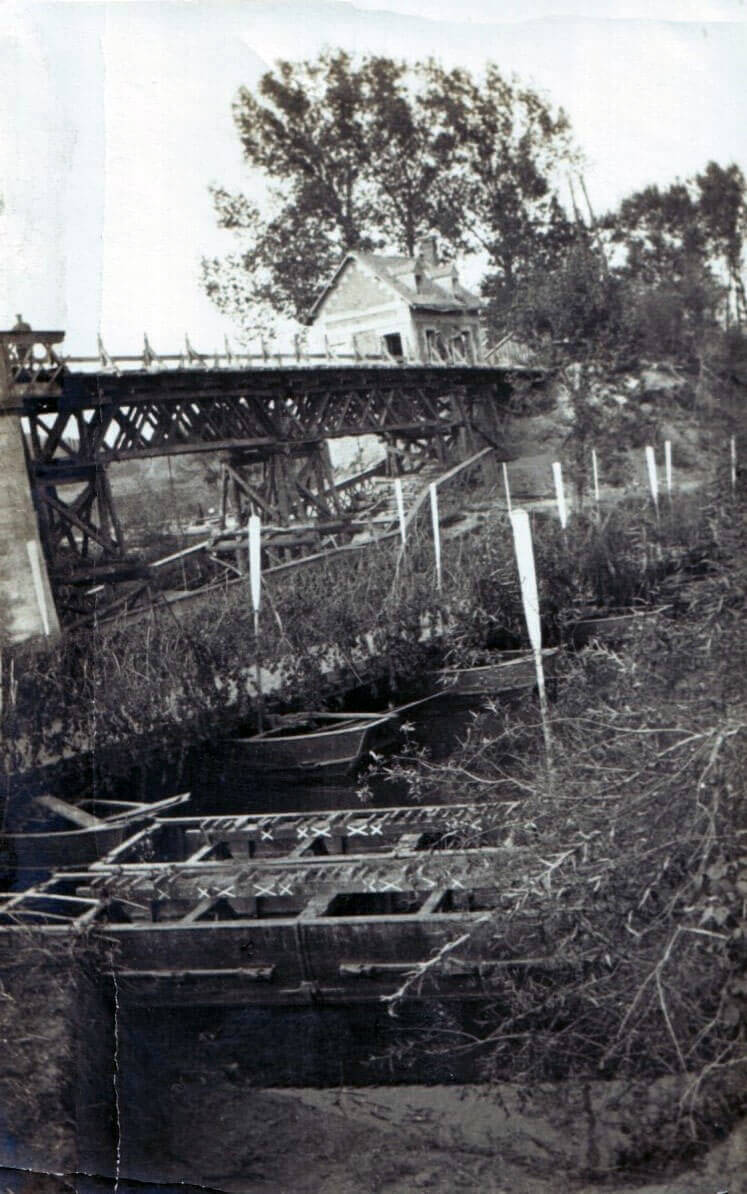
British pontoon bridge built by the Royal Engineers over the Aisne at Bourg, next to the demolished permanent structure. At the far end of the bridge is the house from which German snipers shot soldiers of the 15th Hussars as they crossed (photo by Captain Harry Baird, ADC to General Haig): Battle of the Aisne, 10th to 13th September 1914 in the First World War
French’s orders for the 14th September were to continue the assault on the German positions. Some artillery and the 19th Brigade, as a reserve, were to remain south of the Aisne.
The day began in some confusion for the BEF, the bad weather and spasmodic fighting causing units to become muddled. The day continued with units crossing the Aisne to join their comrades in piecemeal attacks on well-entrenched German infantry, supported by artillery carefully posted in the hilly wooded back areas. British artillery support was inevitably haphazard. The attacking British infantry were repeatedly subjected to strong counter-attacks aimed at driving them back across the Aisne.
On the British I Corps front night reconnaissance showed that the Germans were strongly entrenched in a sugar factory near the Chemin des Dames ridge, north-west of the village of Troyon, and at the cross roads nearby. 2nd Brigade of the 1st Division with two batteries was ordered to take these positions, to enable the rest of the division to pass through the area and capture Chamouille, some three miles to the north in the next river valley, of the Ailette.
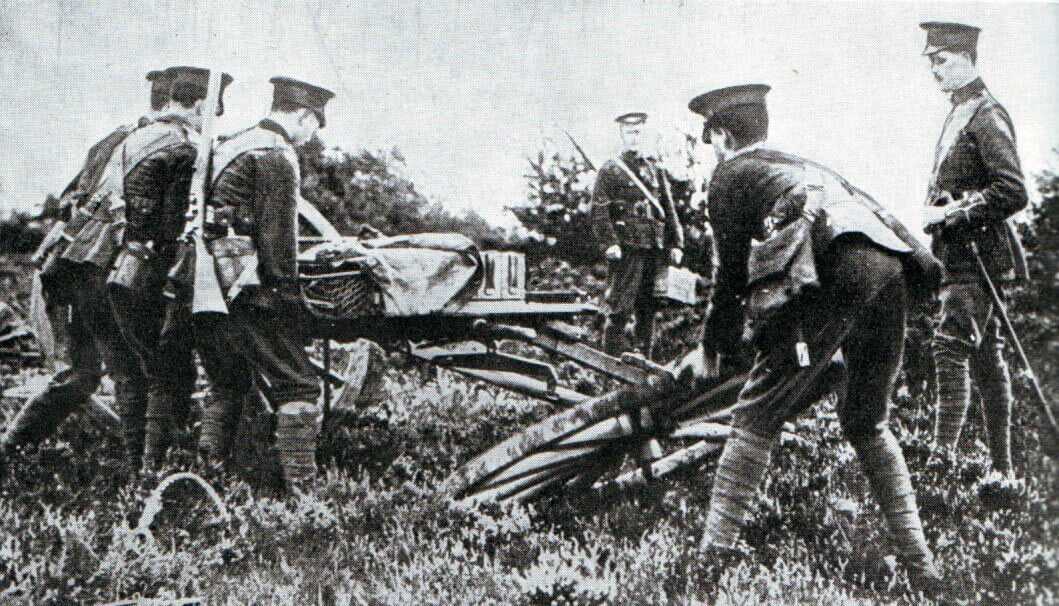
British infantry assembling a machine gun for action during the Battle of the Aisne, 10th to 13th September 1914 in the First World War
At around 3am on the 14th September, in heavy rain and mist, the battalions of 2nd Brigade attacked the German positions on the high ground to the north of Troyon, but without the support of the guns, which did not arrive in time. Several parties of German troops tried to surrender but were fired on by their own side and consequently by British troops as well. Two German batteries were abandoned by their gun crews, leaving the guns unattended in the middle of the struggle.
1st (Guards) Brigade came up on the left flank of 2nd Brigade, with 3rd Brigade in reserve at Moulins. The Cavalry Division remained in the area of Paissey and Vendresse, awaiting the outcome of the infantry battle.
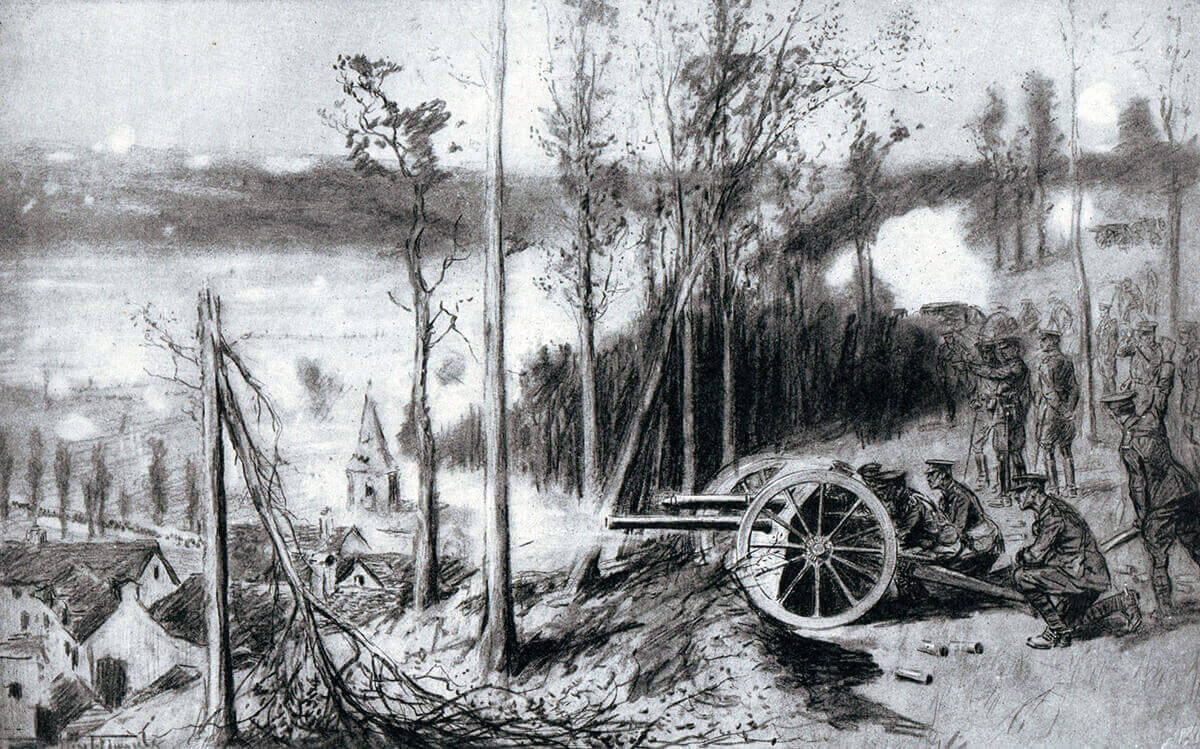
British RFA 18 pounder field gun in action during the Battle of the Aisne, 10th to 13th September 1914 in the First World War
At around 8am the GOC of the 1st Division, Major-General Lomax, fearing that the Germans were preparing to launch a strong counter-attack against his 2nd Brigade, requested the Cavalry Division to cover the right flank of the 2nd Brigade.
Between 8am and 9am the battle intensified, with 2nd Brigade taking the sugar factory to the north-west of Troyon and entrenching on the high ground beyond. Here the battle raged back and forth for the rest of the day, with reinforcing units pushed into the line as and where they were needed.
On the left of the 2nd Brigade, 1st (Guards) Brigade worked forward until they reached the Chemin des Dames roadway, where there was little cover and they were subjected to heavy German artillery fire.
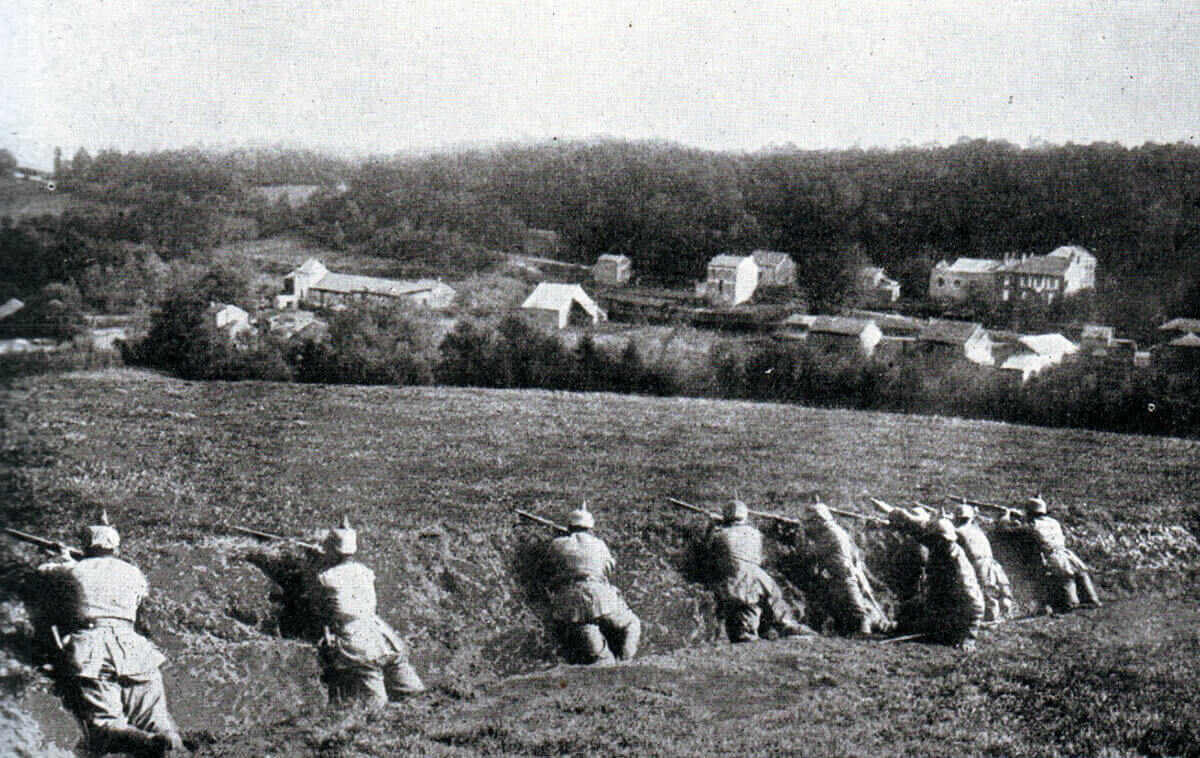
German infantry positioned in a ditch: Battle of the Aisne, 10th to 13th September 1914 in the First World War
The commanding officer of 1st Coldstream Guards, Lieutenant Colonel Ponsonby, lead a party of his men over the highway and penetrated beyond the village of Cerny, where they were well into the German positions.
On the right of the 2nd Brigade, 1st Queen’s also crossed the Chemin des Dames ridge and penetrated the German line, firing on German units in the valley of the Ailette River.
The whole area was covered in thick fog. The German guns were in positions prepared before the battle and put down barrages indiscriminately on British and German units mixed up in the confused fighting, inflicting heavy casualties on both sides. The British batteries took some time to find their way onto the Paissy plateau and were reluctant to open fire, fearing to inflict casualties on the British troops as well as German.
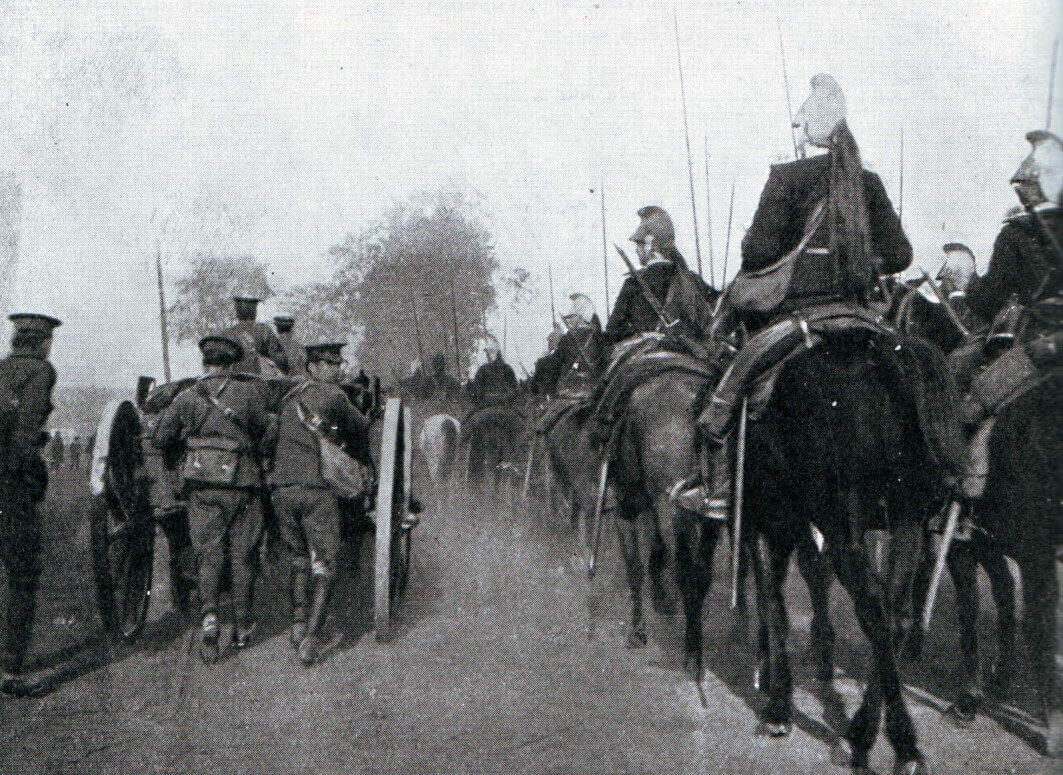
French dragoons passing a British field battery during the advance to the Aisne: Battle of the Aisne, 10th to 13th September 1914 in the First World War
At around 10.30am, while 3rd Brigade deployed in support of 1st (Guards) Brigade, a German counter-attack comprising three battalions of the German 25th Reserve Brigade developed towards Vendresse. This attack was met by an artillery barrage from 46th and 113th Batteries RFA, able to fire by the fog lifting, from positions around Moussy to the south-west of Vendresse.
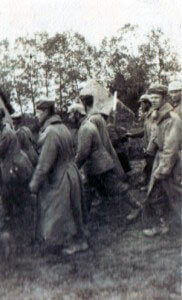
German soldiers captured on 14th September 1914 during the Battle of the Aisne by British troops (photo by Captain Harry Baird, ADC to General Haig)
The German attack was subjected to enfilade fire by the 5th Brigade and was driven back by 2nd Welch Regiment and 1st South Wales Borderers of 3rd Brigade, which in turn established themselves on the spur between Beaulne and Chivy by 1pm. The German battalions were badly mauled and the brigade commander mortally wounded.
The force facing the 1st Division comprised some twelve battalions of the German 13th Reserve Division. These troops were finding the fighting extremely difficult.
A new German counter-attack now developed along the line of the 2nd Brigade and 1st (Guards) Brigade. The attacking German infantry re-took the sugar factory and drove the British line sufficiently far back to threaten the flank of the 1st Cameron Highlanders, which suffered from enfilading machine gun fire. The Germans recovered the field guns abandoned earlier in the battle.
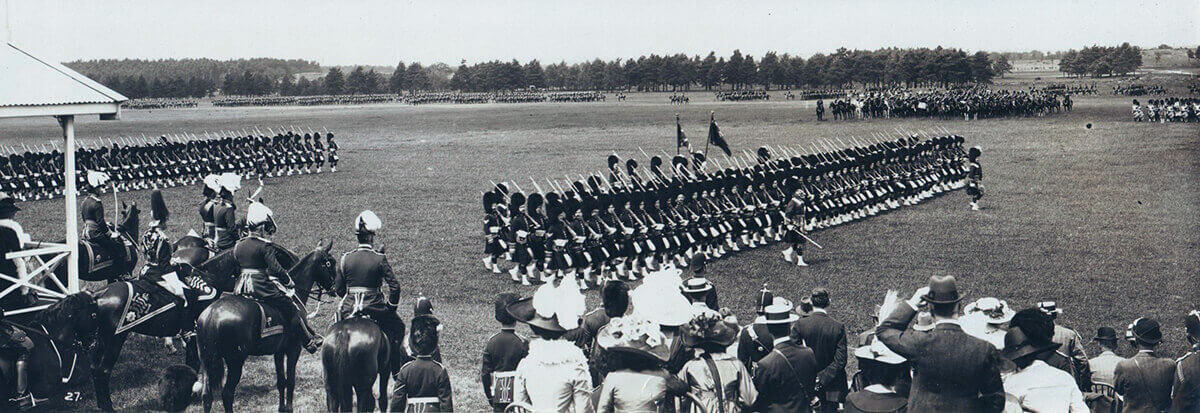
1st Queen’s Own Cameron Highlanders marching past King George V in June 1914 at Aldershot before the Great War: Battle of the Aisne, 10th to 13th September 1914 in the First World War
After suffering heavily during their attack earlier in the day, 1st Camerons was forced to fall back, with other units of 1st Division, until the division established positions to the north of Troyon, where it fought off continuing German attacks until around 3pm when these attacks petered out.
On the left of the 1st Division, the 2nd Division of the BEF’s I Corps was ordered to continue its attack on the German positions.
6th Brigade with XXXIV Brigade RFA and 5th Field Company Royal Engineers was to cross the Aisne River at 5am, by the newly constructed pontoon bridge at Pont Arcy, pass through the positions of the 5th Brigade on the heights north of Pont Arcy, and advance to the Chemin des Dames, where it was to halt and await further instructions. 5th Brigade was to follow the 6th Brigade, while the 4th (Guards) Brigade was to follow the 6th in crossing the Aisne, then head north-west for Soupir and take the ridge beyond la Cour Soupir. The remaining divisional formations of artillery and other services were to follow the Guards, the heavy batteries crossing at Bourg.
2nd Division’s attack began with the advance of the 6th Brigade. Its crossing of the pontoon bridge at Pont Arcy was slow and took until 8am. 1st Berkshires with companies of 1st KRRC and divisional cavalry from 15th Hussars pushed up the banks of the Oise and Aisne canal, heading north-west towards Braye. Short of Braye the 1st Berkshires were halted by heavy German shelling from beyond Braye. The 1st King’s came up on the right between the 1st Berks and the two companies of 1st KRRC, with the rest of 1st KRRC on the western flank, and the advance was resumed, supported by divisional artillery firing from the edge of the ridge south of Moussy. The attack was not co-ordinated, due to the difficult conditions and the heavy German fire, the 1st Berks outstripping the other two battalions. 1st Berks reached the lower part of the Chemin des Dames beyond Braye, but were halted there by the German fire. The two KRRC companies followed the Berks up on their flank, but neither regiment was able to make headway against the rows of German trenches dug into the side of the ridge, supported by heavy gunfire from well positioned field guns and heavy howitzers. Additionally the KRRC was subject to enfilade machine gun fire.
The Germans counter-attacked along the brigade line, driving the 1st Berks and 1st King’s back to the ground north of Moussy.
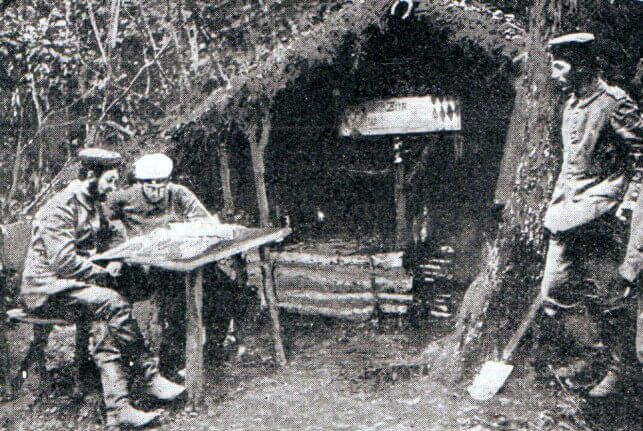
German officers in a position on the Aisne: Battle of the Aisne, 10th to 13th September 1914 in the First World War
On the brigade’s left flank, 1st KRRC was supported by 2nd Worcestershire and 2nd HLI, with gunfire from 46th and 113th Batteries RFA, and drove the Germans back after desperate fighting, inflicting heavy losses on the German infantry.
The 4th (Guards) Brigade was due to come up on the left of the division, but was delayed. While 2nd Grenadiers started crossing the Aisne at 8.30am on schedule, the last battalion in the brigade, 1st Irish Guards, was not across the river until around 10.30am.
2nd Connaught Rangers of 6th Brigade moved up onto the heights around la Cour de Soupir, to secure the area for the Guards. Confused and desperate fighting developed, as the Germans counter-attacked in strength. The 4th (Guards) Brigade came up and launched several attacks, with 1st KRRC on their right flank. The British units inflicted heavy casualties on the Germans and managed to secure the position, leaving 2nd Division with a line stretching from the area of Beaulne to la Cour de Soupir and on to Chavonne. Both divisions of I Corps were firmly established, not as far as the Chemin des Dames ridge, the planned objective, but still well forward, with the artillery of the two divisions in position and firing on the Germans moving across the ridge.
To the west of I Corps lay the BEF’s II Corps. At the beginning of 14th September the 9th Brigade, the right hand brigade of the 3rd Division of II Corps, held positions from a farm on the high ground to the north-east of Vailly extending west, with the 8th Brigade on its left, to the spur between Jouy and Sancy. That left a gap between the left of I Corps and the right of II Corps of nearly two miles.
At dawn the battalions of 8th Brigade advanced, supported by the divisional artillery positioned on both sides of the Aisne, although the batteries that had crossed the river had difficulty finding fire positions. The attack penetrated across the crest of the ridge where it foundered against the German entrenched positions.
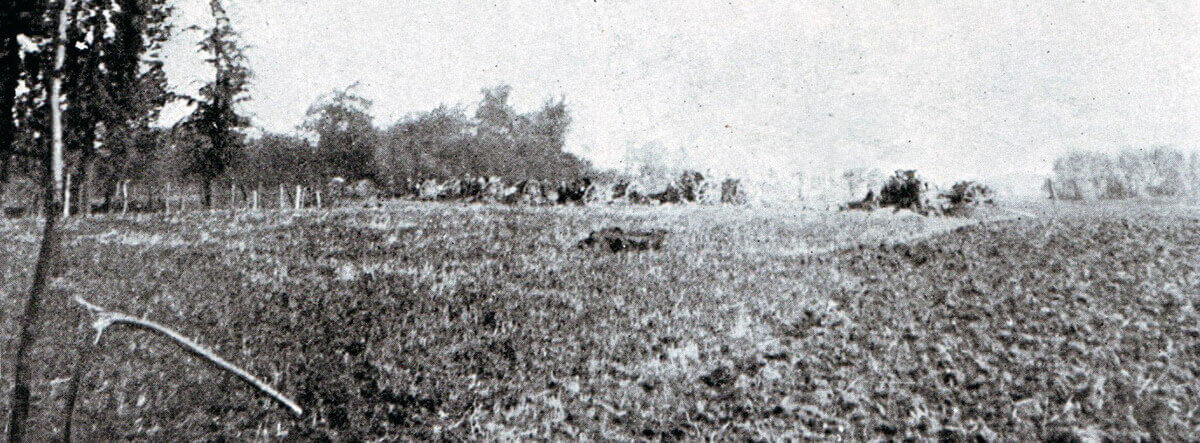
British RFA battery in action during the Battle of the Aisne, 10th to 13th September 1914 in the First World War
The 9th Brigade, after repelling a German counter-attack, advanced to drive back the German guns positioned in the valleys leading south and firing on the pontoon bridges across the Aisne. As this attack moved forward the Germans launched a heavy counter-attack on the 8th Brigade, positioned on the Jouy Spur, supported by enfilading machine gun fire. The 8th Brigade suffered heavy casualties and at around 10am began to fall back. The divisional commander ordered the 7th Brigade, still on the south bank of the Aisne, to support the 8th Brigade.
The 7th Brigade moved forward to the pontoon bridge in Vailly but found the German artillery fire to be too heavy to cross. The brigade moved to the damaged railway bridge to find that it was being crossed from north to south by troops from 9th Brigade, forced to retire by the heavy German attack. The 1st Lincolns were falling back, leaving 4th Royal Fusiliers exposed to heavy flanking fire. The other battalions of the brigade, especially 1st Northumberland Fusiliers, suffered heavy casualties, and the brigade was forced back, some of the Lincolns re-crossing the Aisne.
The situation was critical, particularly due to the wide gap between I and II Corps. The flanks of the 4th (Guards) Brigade of I Corps and 9th Brigade of II Corps were in the air. The only reserves in Vailly were the Royal Scots Greys and the 12th Lancers of the 5th Cavalry Brigade and these regiments were under heavy artillery fire. Either because there were no German troops available or because they did not appreciate the opportunity, no German attack was launched into the gap between the two corps.
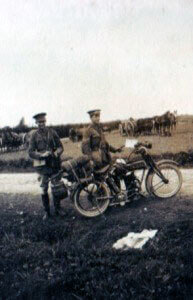
Motor cyclists of 5th Cavalry Brigade with the Royal Scots Greys machine gun section in the background (photo by Captain Harry Baird, ADC to General Haig)
The II Corps artillery positioned around Chassemy did the best they could to support the formations on the north side of the Aisne, firing on the German gun positions and the assembling infantry attacks.
During the afternoon 1st Wiltshire and 2nd Royal Irish Rifles crossed the Aisne by the railway bridge and came up in support of 9th Brigade, partly filling the gap. The 8th Brigade on the left of the 3rd Division fell back behind the Jouy Spur, thereby enabling the division to consolidate its line and hold off further attacks during the rest of the day.
With the reduction in German artillery fire the 5th Cavalry Brigade and XL Brigade RFA re-crossed to the south bank of the Aisne. The cavalry crossed the pontoon bridge at Vailly in single file. In spite of the continued gunfire the only fatality was Captain Wright Royal Engineers, who was supervising the crossing and had won the Victoria Cross at the Battle of Mons.
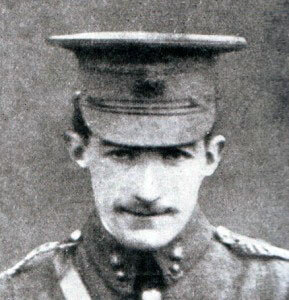
Captain Wright Royal Engineers awarded the Victoria Cross for his conduct at Mons and the Aisne. Captain Wright was killed on 14th September 1914: Battle of the Aisne, 10th to 13th September 1914 in the First World War
The guns were forced to march to Pont Arcy, some five miles to the east, under fire on several occasions, and cross there.
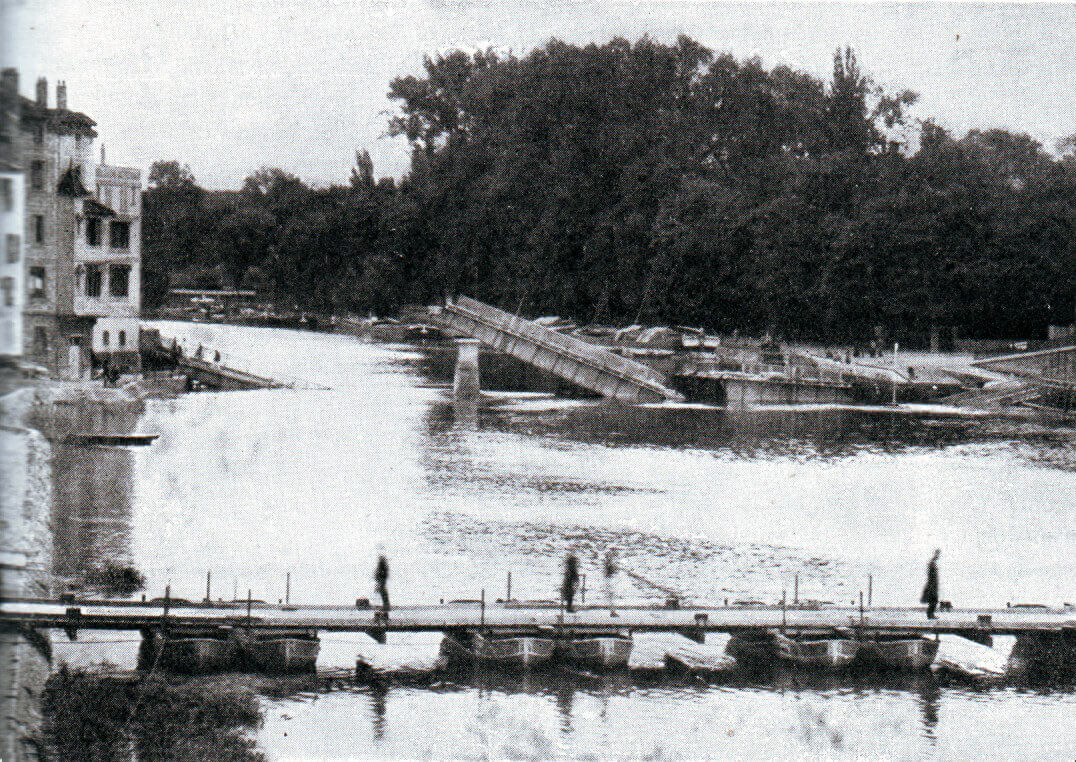
British pontoon bridge built by the Royal Engineers at Pont Arcy during the Battle of the Aisne, 10th to 13th September 1914 in the First World War
On the left of the BEF the remaining two infantry divisions, the 5th (of II Corps) and 4th (of III Corps) fought a separate battle, due to the barrier imposed by the Chivres promontory, immediately north of Missy. The 14th Brigade had crossed the Aisne on the 13th September and was in place on the high ground west of St Marguerite. The 15th Brigade crossed the Aisne by the railway bridge and reached St Marguerite early on 14th September.
The 1st RWK and 2nd KOSB of 13th Brigade crossed the Aisne during the night of the 13th September near the ruined bridge in Missy, using boats and rafts. The other two battalions of 13th Brigade remained south of the river.
The operational orders for 4th Division on the 14th September required its brigades to continue the attack to the north. 13th Brigade with VII Brigade RFA was to advance on Cessières via Celles, while the remaining brigades, 14th and 15th, marched to Suzy via Missy. However the German positions on the Chivres spur and Fort de Condé made these orders impracticable. An enveloping attack was planned, with 13th Brigade attacking straight onto the Chivres spur from Sainte Marguerite, with the 15th Brigade mounting an assault on the spur from the south-east, once 14th Brigade had taken Missy. The attack was to be supported by the division’s artillery.
The 14th and 15th Brigades experienced considerable difficulty fighting through Missy, due to heavy German artillery bombardment and machine gun fire from trenches protected by barbed wire. This was only achieved by around 4.30pm when it was found that the confusion of the units was so great that the attack had to be called off. This was in spite of considerable progress being made by 1st Bedfordshire and 1st DCLI, which fought into the German positions before being forced to withdraw when the attack was abandoned. The 14th and 15th Brigades reformed and entrenched along a line from St Marguerites to beyond Missy.
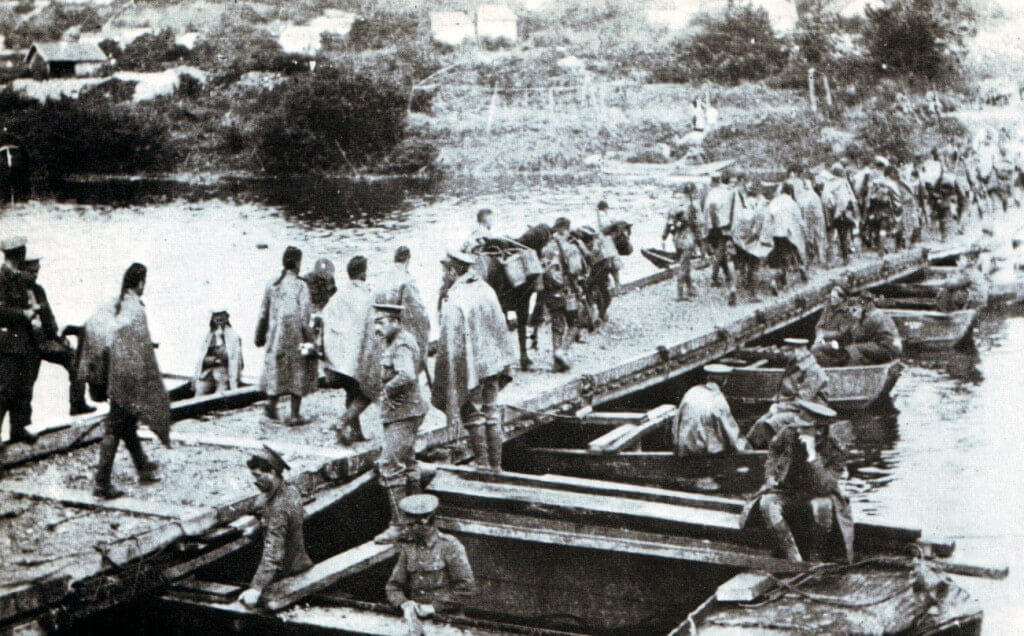
British troops crossing a pontoon bridge built by the Royal Engineers: Battle of the Aisne, 10th to 13th September 1914 in the First World War
On the western flank of the BEF the 4th Division (III Corps) was ordered to attack north onto the plateau between Vregny and Crouy and push back the German artillery that was bombarding the French 6th Army troops operating in Soissons and relieve the pressure on the 5th Division to its east. The attack was to start from the 11th Brigade positions secured along the ridge north of the Aisne by Hunter-Weston on the 13th September.
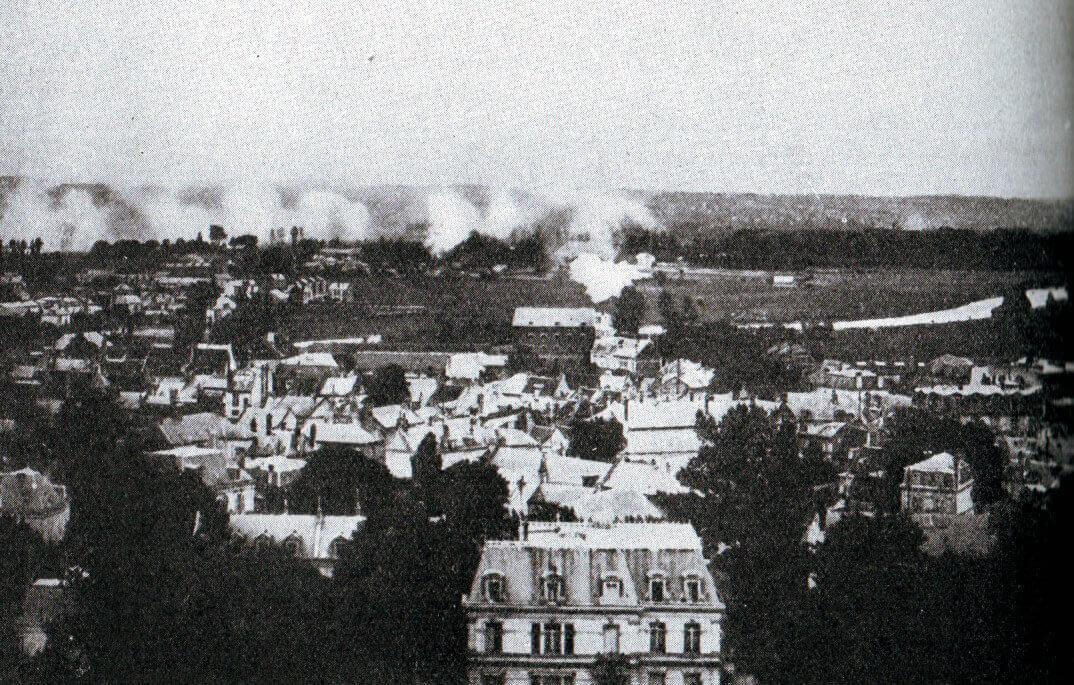
Soissons under German bombardment during the Battle of the Aisne, 10th to 13th September 1914 in the First World War
During the morning of 14th September the 10th Brigade crossed the Aisne River and joined the 11th Brigade, while the 12th Brigade came up on the right with its right flank angled back into the Chivres valley.
The German positions facing the 4th Division were heavily entrenched and strongly supported by artillery and machine guns.
Although several of the 4th Division’s artillery batteries crossed to the north side of the Aisne, there was such difficulty in finding fire positions that the GOC of the division expressed extreme reservations on any advance unless it was in co-ordination with similar advances to his left by General Manoury’s French 6th Army and the 5th Division to his right. The French had no heavy artillery in the area and were unable to progress beyond Soissons and the attack by the 5th Division was heavily bogged down.
The 4th division spent the day digging itself into the positions it was holding, suffering casualties from German fire. When a German attack seemed to be developing a single company of 2nd Royal Dublin Fusiliers went forward and dispersed the attack with heavy accurate rifle fire.
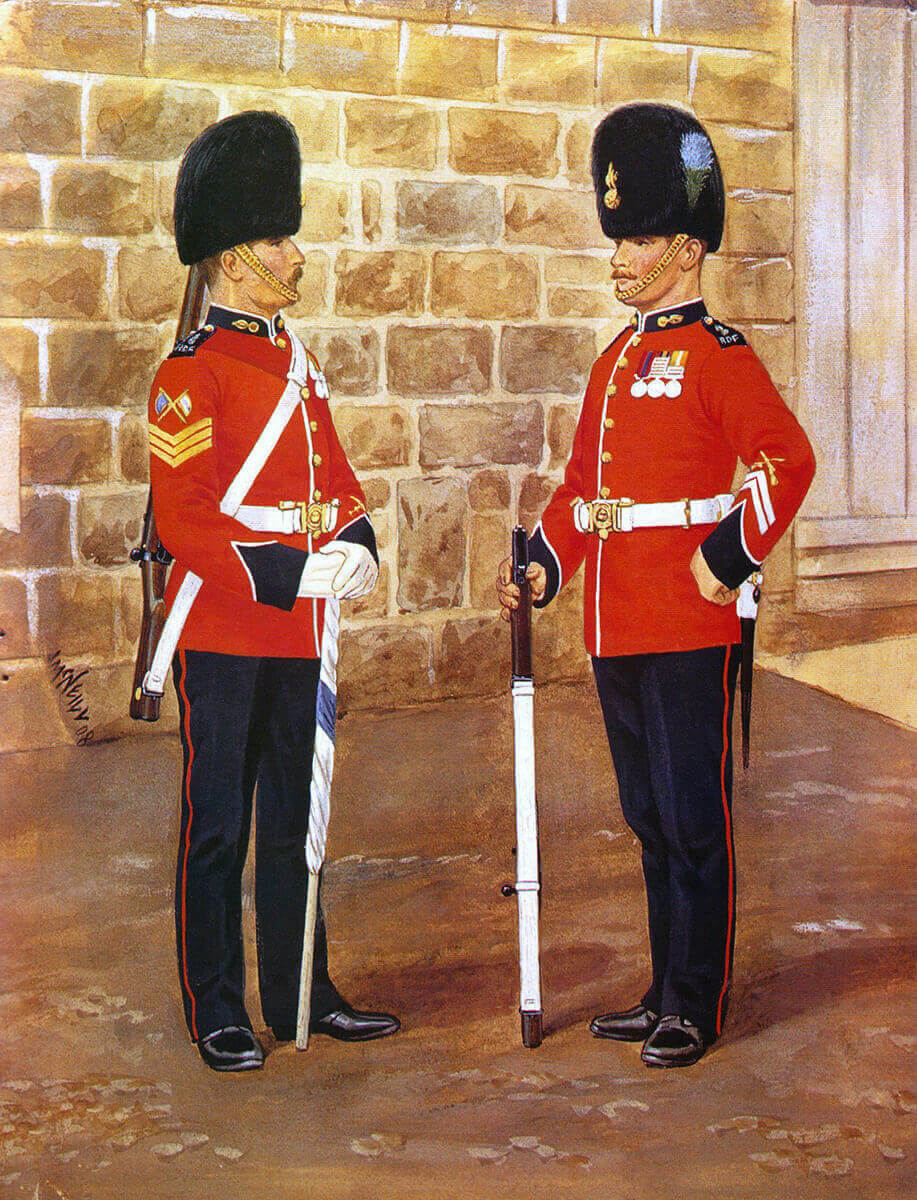
Royal Dublin Fusiliers 1909: Battle of the Aisne, 10th to 13th September 1914 in the First World War
On the right flank of the BEF, the failure of the attack by the 3rd Division left the 2nd Division in an exposed position, further forward and with a large gap between the two formations. No infantry reserves were available. Soon after 2pm General Haig arranged for the 1st and 2nd Cavalry Brigades to move to the left of I Corps near Soupir. At around 3.30pm the 1st Cavalry Brigade moved further west to Chavonne, held by two companies of 2nd Coldstream Guards. A cavalry regiment was despatched up the slope beyond Chavonne, where they made contact with the 3rd Division. The gap between I and II Corps was closed.
In the belief that the Germans were at last retreating, Major General Munro, commanding the 2nd Division, ordered his division to resume its stalled attack towards Courtecon. The 4th (Guards) Brigade began its advance from the area of la Cour Soupir. There was almost no artillery support, due to the difficulty of finding positions for the field artillery on the north bank of the Aisne. A German counter-attack from Ostel halted this advance and the Guards were left to hold their positions until dark, entrenching and bivouacking. The 6th Brigade and the remaining units of the 5th Brigade were able to achieve little, other than to hang onto the positions they were in.
On the right of the BEF, where the 1st Division had achieved an advance up to and beyond the Chemin des Dames, the division was forced to fall back to positions lower down the ridge. The sugar factory near Troyon remained in German hands.
To the right of the BEF the French XVIII Corps recovered from its initial reverses earlier in the day and took Craonne.
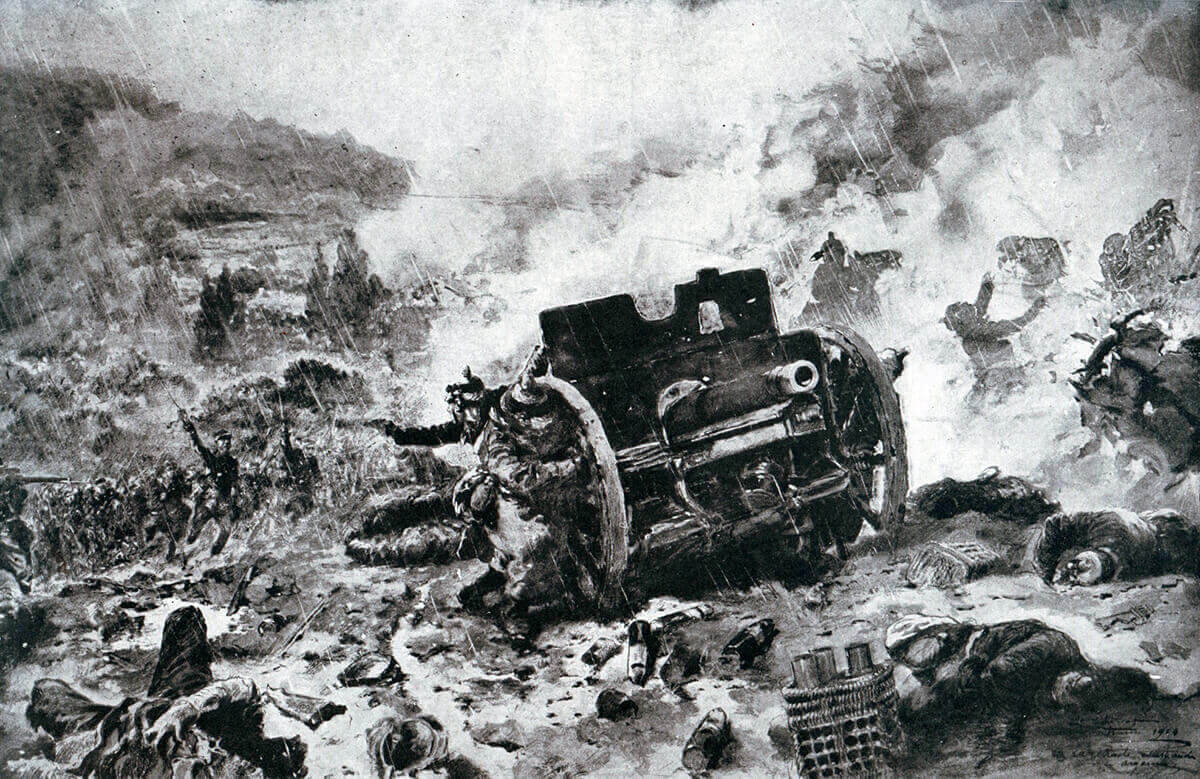
French infantry attacking a retreating German gun battery: Battle of the Aisne, 10th to 13th September 1914 in the First World War
The positions of the various BEF formations at the end of the 14th September 1914 were:
4th Cavalry Brigade: Paissy and Geny, between the BEF and the French 5th Army.
1st Division (I Corps): From the Chemin des Dames 1,000 yards east of Troyon to Chivy.
2nd Division (I Corps): Beaulne to Chavonne.
1st and 2nd Cavalry Brigades: west of Chavonne to the mill.
3rd Division (II Corps): from the mill to a point on the Aisne to the west of Vailly.
5th Division (II Corps): from Missy to Sainte Marguerite.
4th Division (III Corps): from Saint Marguerite north-west and west to a point west of Crouy.
19th Brigade (III Corps): on the south bank of the Aisne River at Venizel.
3rd and 5th Cavalry Brigades: on the south bank of the Aisne River between Chassemy and Augy.
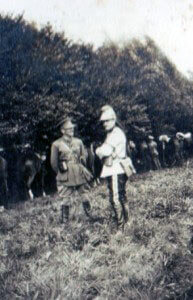
Officers, British and French, of 5th Cavalry Brigade (photo by Captain Harry Baird, ADC to General Haig)
Communications from Sir John French to General Joffre acknowledged that the Germans were no longer retreating, and that it would be necessary to carry out a set piece attack on the German positions along the north bank of the Aisne River to reach the Chemin des Dames ridge.
In fact over the next few days the main attacks were carried out by the Germans. The British artillery was carefully positioned and conducted a continuing duel with the German guns. The infantry positions of each side were now entrenched, making attacks increasingly difficult, particularly in view of the extensive and searching artillery cover over the Aisne valley.
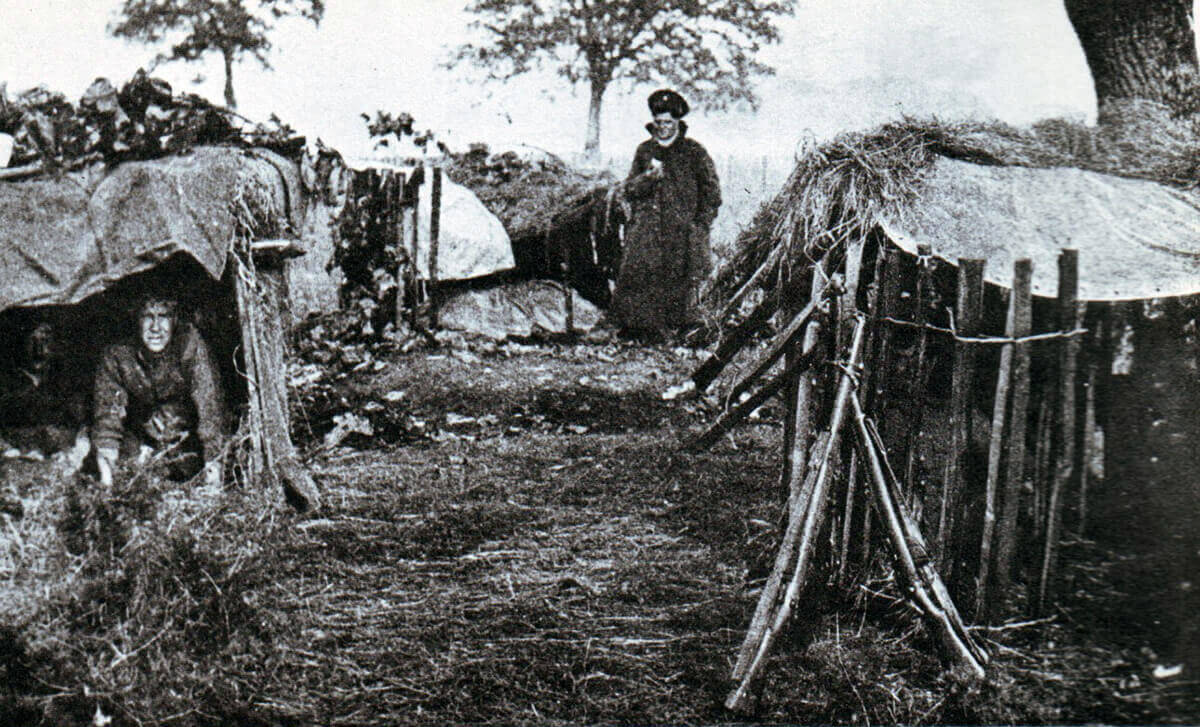
British troops in bivouacs on the battlefield: Battle of the Aisne, 10th to 13th September 1914 in the First World War
The position of the BEF on the north bank of the Aisne was difficult due to the German artillery. The bridges were either destroyed or extensively damaged and replacement pontoon and boat arrangements were subjected to more or less continuous German gun fire.
upplies had to be brought up during the night and could not be stored on the north bank. Moving casualties out required stretcher bearers to carry them to the south bank before they could be loaded onto ambulances.
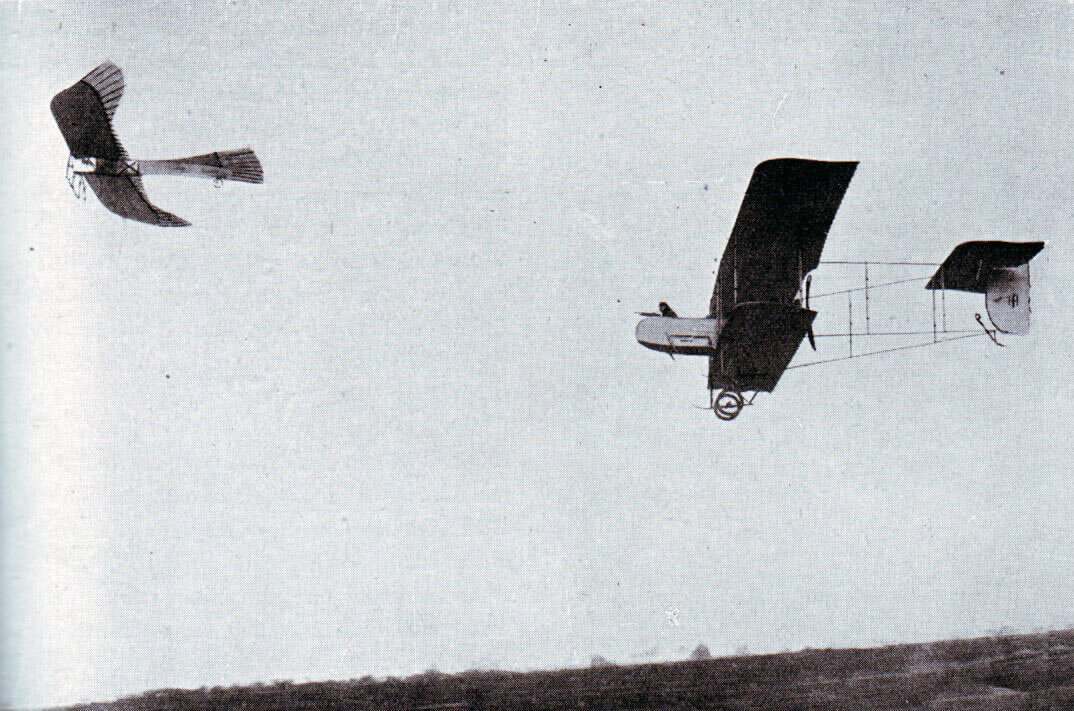
French aircraft chasing a German Taube: Battle of the Aisne, 10th to 13th September 1914 in the First World War
15th September 1914:
During the morning of the 15th September 1914 Field Marshal Sir John French instructed his various Corps to entrench the positions they then held, so as to hold out against the attacks it was expected the Germans would now launch.
In an acknowledgement of the difficulty created for the British by the preponderance of heavy German artillery and the care with which it was positioned, French directed that the 60 pounders, the heaviest guns widely available to the BEF and significantly smaller than the Germans’ heavy howitzers, should seek out the German batteries in turn with their gunfire.
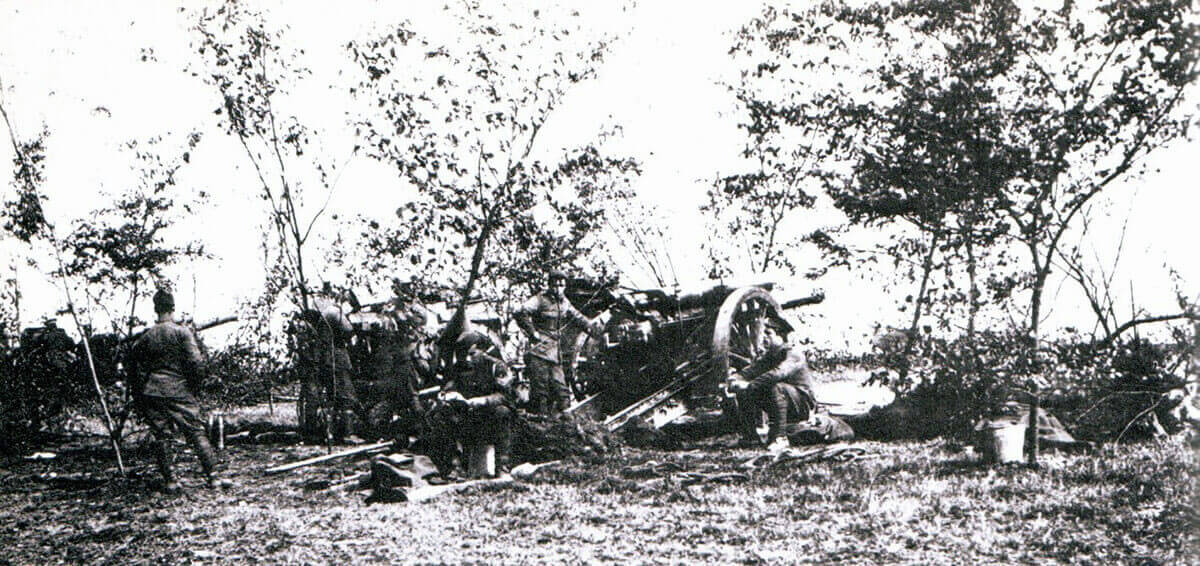
British 60 pounder guns on the battlefield: Battle of the Aisne, 10th to 13th September 1914 in the First World War
A telegram from General Joffre to his army commanders in the early afternoon stated that the Germans were in fixed positions that they intended to fight for, directing that it was no longer a matter of pursuit by the French (and the British) army, but now one of set piece attacks.
For the BEF the 15th September was a day largely of German, rather than British, attacks. The British 3rd Division suffered assaults all along its line, beating them off with heavy German casualties.
To the west the 5th Division spent the day making a further attempt to take the Chivres spur. This was frustrated by the additional entrenchments dug by the Germans and the heavy artillery bombardment put down by the Germans on the assaulting troops. During the morning a German aeroplane spotted British troops crowded into Missy and a heavy artillery bombardment forced the evacuation of the town for a time.
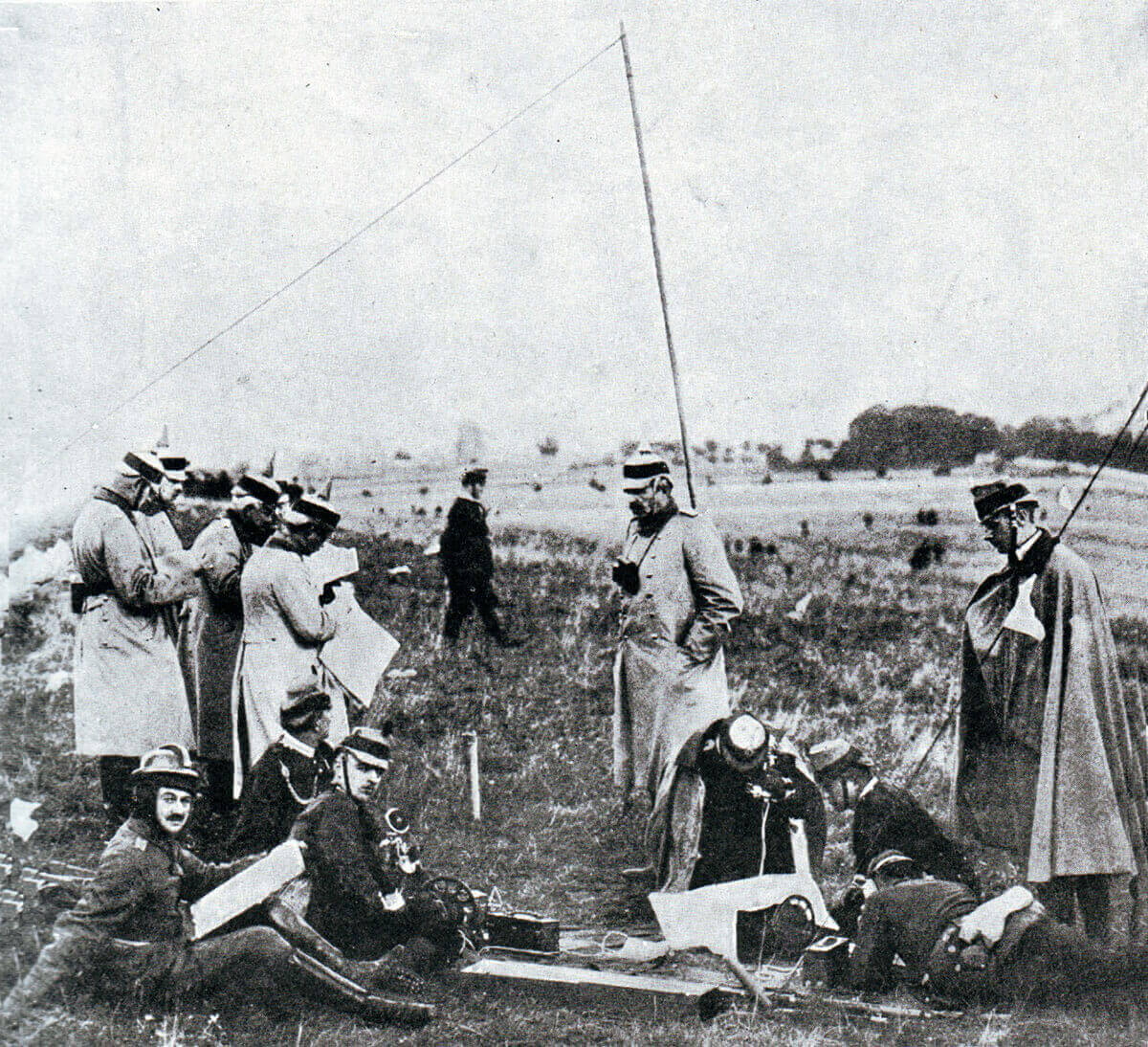
German pilots being briefed during the Battle of the Aisne, 10th to 13th September 1914 in the First World War
It became apparent that the capture of the Chivres spur was beyond the capability of the small number of British troops available, coupled with the difficulty of deploying in the narrow area the British occupied on the north bank of the Aisne.
At the eastern end of the BEF line I Corps suffered artillery bombardments and small local infantry attacks which were all beaten off.
The 4th Division, at the western end of the BEF line, spent the day improving its entrenchments and collecting agricultural barbed wire, in the absence of any army supplies of this essential defensive implement.
The Battle of the Aisne was essentially over, giving way to the trench warfare in the area that would continue for several years.
Casualties at the Battle of the Aisne:
In the operations between 13th and 15th September 1914 BEF’s I Corps suffered casualties of around 3,500 men killed wounded and missing.
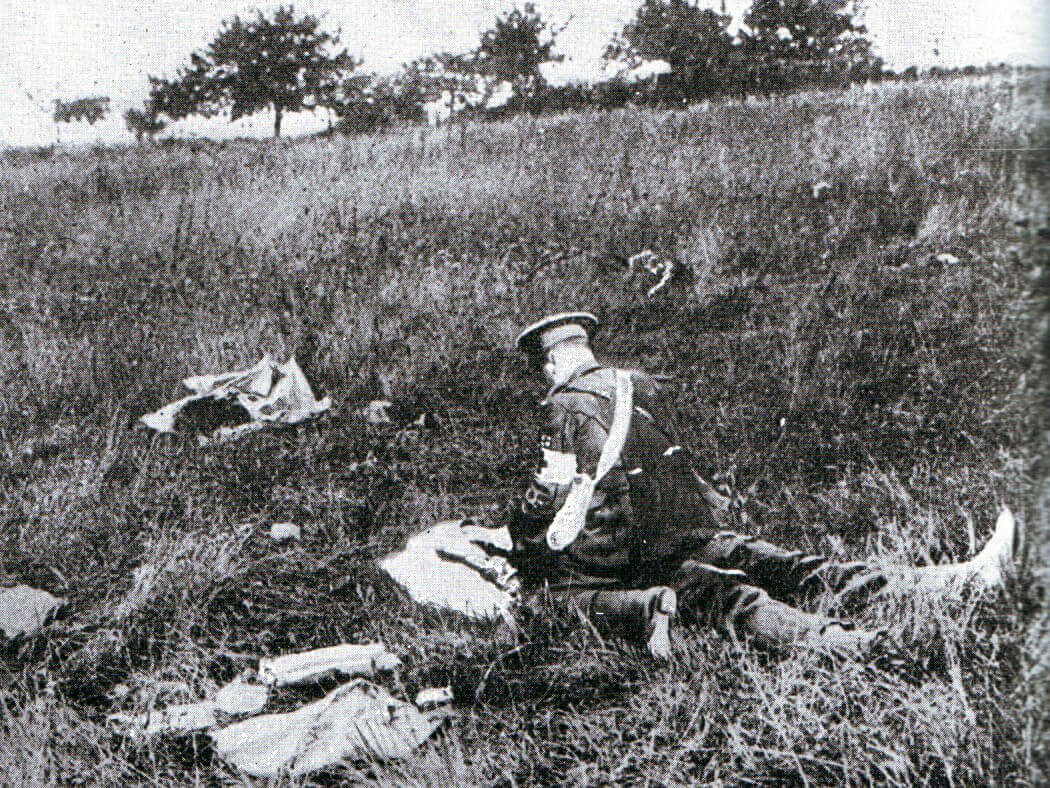
British medical orderly attending a casualty on the Battlefield: Battle of the Aisne, 10th to 13th September 1914 in the First World War
3rd Division lost around 1,000 men killed wounded and missing.
5th and 4th Divisions lost around 500 men killed wounded and missing
Total casualties for the BEF in the battle were around 5,000.
On 14th September 9th Brigade lost 650 men and 7th and 8th Brigades lost 150 men each.
On 14th September 5th Division suffered around 100 casualties per battalion.
The 4th (Guards) Brigade suffered casualties of 21 officers and 566 soldiers.
German casualties are unknown but are likely to have been in excess of 10,000 killed wounded and captured.
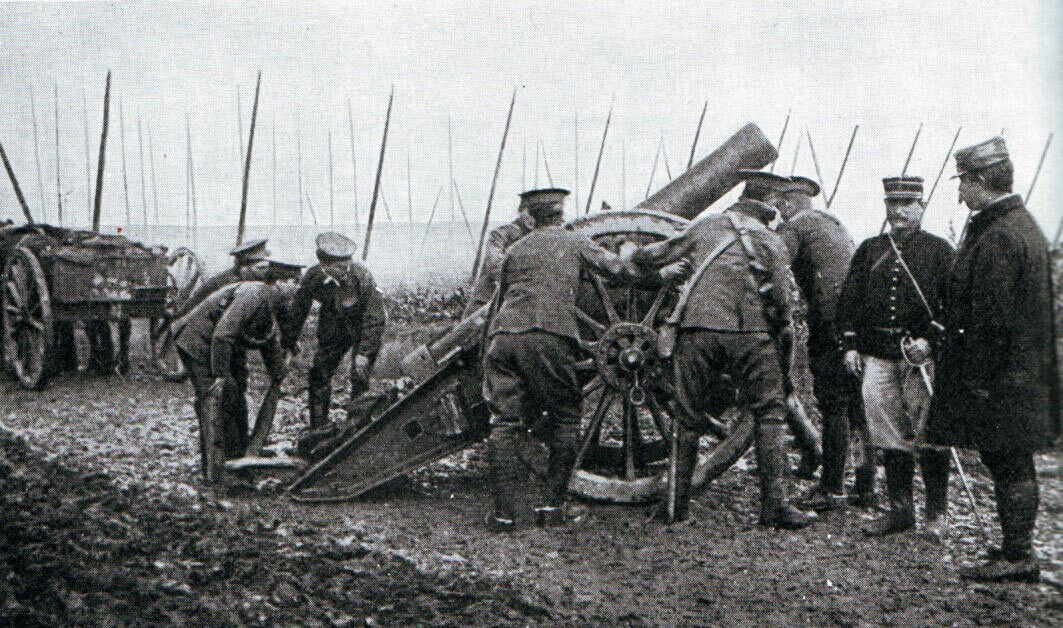
British howitzer on the battlefield: Battle of the Aisne, 10th to 13th September 1914 in the First World War
Aftermath to the Battle of the Aisne:
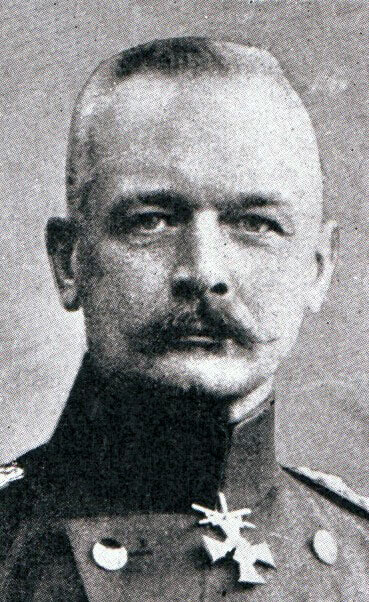
Lieutenant-General von Falkenhayn: Battle of the Aisne, 10th to 13th September 1914 in the First World War
There is no doubt that the Battle of the Marne and the Aisne, although not having as decisive a result as General Joffre and Sir John French hoped for, were nevertheless a serious reverse for the Germans. General von Moltke was relieved of his duties as Chief of Staff of the German Army (effectively the Commander-in-Chief, although that position was formally held by Kaiser Wilhelm II), and replaced by Lieutenant General von Falkenhayn, the Minister of War.
Moltke’s removal was kept secret and he remained formally in post until, suffering from ill health, he returned to Germany in November 1914, dying in 1916. In the light of these battles and the failing Austro-Hungarian Army in the East, Falkenhayn said privately that the War was as good as lost.
From the 15th September 1914 trench warfare became established on the Aisne front, as both sides entrenched. The German Army sought to outflank the Allies by marching north to the Belgian coast. Similarly the French extended northwards. The arrangement was made that the British Expeditionary Force would pull out of the Aisne Front and transfer to Flanders. This move took place during the first three weeks of October 1914.
Medals and Decorations for the Battle of the Aisne:
See this entry on the Battle of Mons.
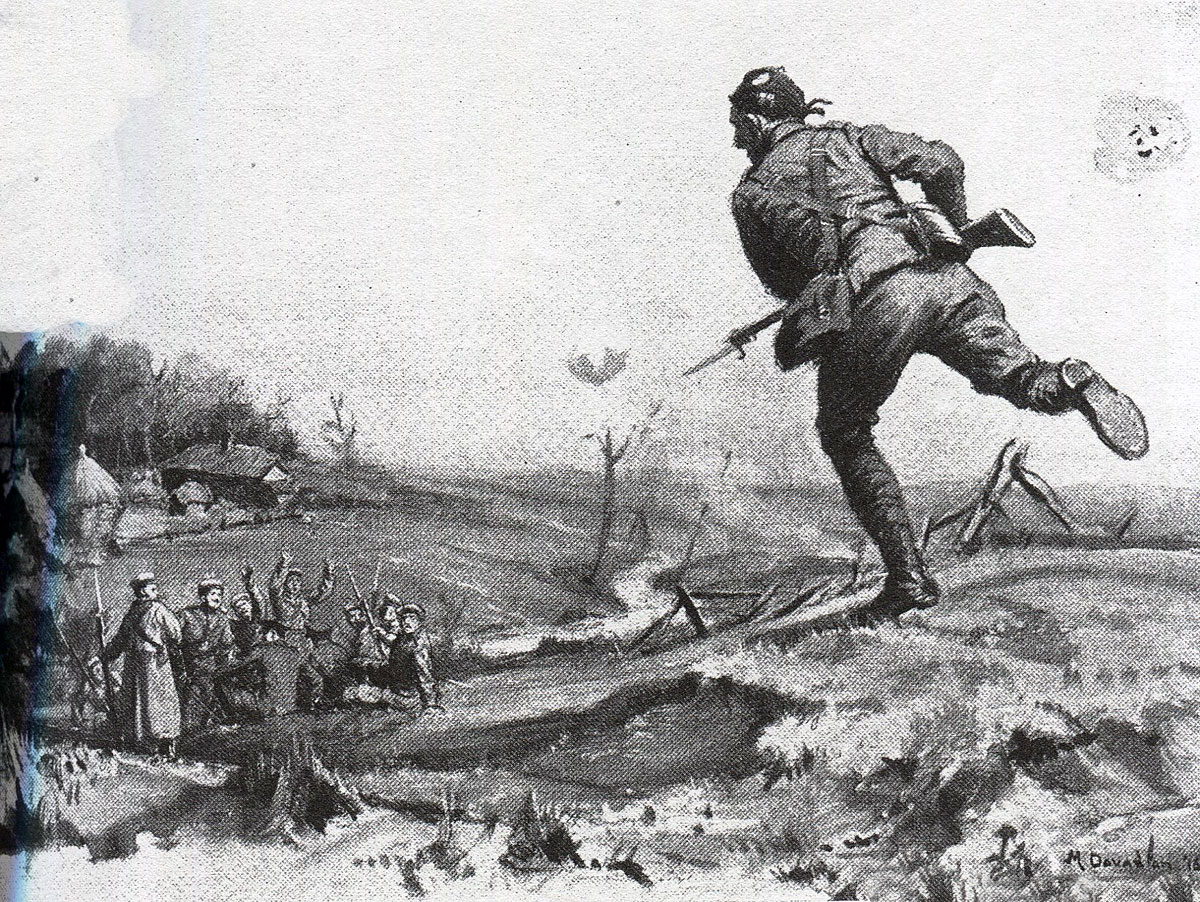
Private George Wilson 2nd HLI winning the Victoria Cross at the Battle of the Aisne, 10th to 13th September 1914 in the First World War
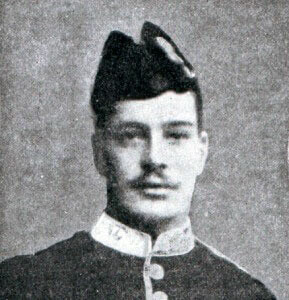
Private George Wilson 2nd HLI awarded the Victoria Cross for his conduct at the Battle of the Aisne, 10th to 13th September 1914 in the First World War
Victoria Crosses were awarded for conduct during the Battle of the Aisne to Private William Fuller of 2nd Welch Regiment, Captain William Johnston Royal Engineers for his work in ferrying 15th Brigade across the Aisne at Moulin des Roches with Lieutenant Flint Royal Engineers, who was awarded the DSO, Private George Wilson of 2nd HLI and Private Ross Tollerton of 1st Cameron Highlanders. Captain Wright Royal Engineers received the VC for his conduct at the Battle of Mons and in ensuring the crossing of the Aisne by the 5th Cavalry Brigade at Pont Arcy on 14th September 1914, during which he was killed.
Anecdotes and traditions from the Battle of the Aisne:
• The Official History of the Great War described 14th September 1914 as ‘the beginning, for the British, of trench warfare’.
• Major G.J.P. Geiger of 2nd Royal Welch Fusiliers described in ‘The War the Infantry Knew’ seeing Major-General Hunter-Weston, the officer who took his 11th Brigade across the Aisne on 13th September, during the Battle of the Marne: ‘I have a vivid recollection of this distinguished officer early in the day’s proceedings careering past me on the flapper’s perch of a motor bicycle, and of thinking how such a means of transport was possible only for a British General; it would, even in the last days of the War, have been inconceivable for a Frenchman, or for a German- even in defeat, to get about in such an unseemly manner’.
• While the BEF was on the Aisne, numbers of soldiers and wagons turned up after losing contact with their units during the retreat after the Battle of Mons. One transport wagon rejoined the 3rd Cavalry Brigade on 21st September 1914, after going missing on 24th August 1914. Several Royal Dublin Fusiliers rejoined their battalion after escaping through German lines after the Battle of Le Cateau to Boulogne.
• Lieutenant-Colonel Ponsonby, the commanding officer of 1st Coldstream Guards, with his party of some forty Coldstreamers and Black Watch lay behind German lines to the north of Cerny on the night of 14th September. A German battalion occupied Cerny and sentries were posted near the Coldstreamers. At around midnight the group made its way through the area occupied by the Germans reaching British lines at dawn, the wounded Ponsonby carried by two soldiers.
• During this period most of the regiments exhausted their supplies of reservists and began to incorporate soldiers from the Special Reserve, the old Militia, into their ranks.
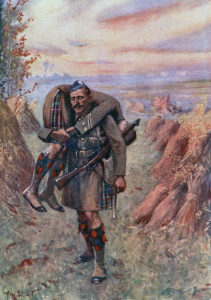
Private Ross Tollerton 1st Queen’s Own Cameron Highlanders awarded the Victoria Cross for his conduct, rescuing Captain Matheson, at the Battle of the Aisne, 10th to 13th September 1914 in the First World War: picture by Allen Stewart
 • The Royal Engineers built a number of pontoon bridges over the Aisne and repaired others. A wooden girder bridge was built in Soissons and handed to the French. It became known as the ‘Pont des Anglais’. Apparently its replacement still bears that name.
• The Royal Engineers built a number of pontoon bridges over the Aisne and repaired others. A wooden girder bridge was built in Soissons and handed to the French. It became known as the ‘Pont des Anglais’. Apparently its replacement still bears that name.
• Private William Fuller of 2nd Welch Regiment won his VC for rescuing his wounded officer, Captain Mark Haggard, carrying him back a mile to a dressing station. Captain Haggard was the nephew of Henry Rider Haggard, the author of King Solomon’s Mines, who presented Fuller with a Hunter Watch. Unfortunately Captain Haggard did not survive the battle.
References for the Battle of the Aisne:
The Official History of the Great War by Brigadier Edmonds August-October 1914.
Times History of the Great War
Mons, The Retreat to Victory by John Terraine.
The First Seven Divisions by Lord Ernest Hamilton.
History of the 2nd Division 1914-1918 Volume 1 by Wyrall
The Grenadier Guards in the Great War of 1914-1918 Volume 1 by Ponsonby
The Coldstream Guards 1914-1918 Volume 1 by Ross of Bladensburg
The Irish Guards in the Great War 1st Battalion by Rudyard Kipling
The previous battle in the First World War is the Battle of the Marne
The next battle in the First World War is the Texel Action
